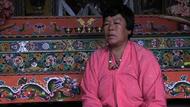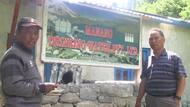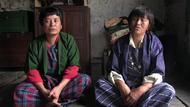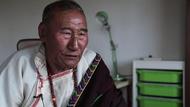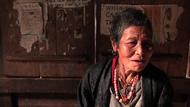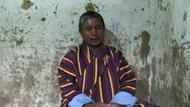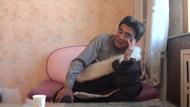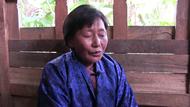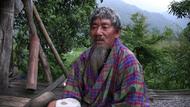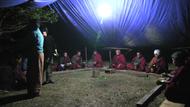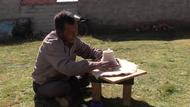Video Overview
The Early History of the Bön Tradition. An oral commentary on The Early History of the Bön Tradition from Tsultrim Puntsok's Bön gyi ta nyé rik né ten chö chok trik. Lha sa 1996, pp. 199-205.
- Lhasa
- སྐྱེས་པ་ Manལྟ་ང་ཚོ་དེ་རིང་བོན་པོའི་ལོ་རྒྱུས་སྐོར་ཏིག་ཙམ་ཞུ་ཡག་ཡིན་ངས།Today, I am giving to give a brief talk on Bön history.
- ལྟ་ཞུ་ཡག་དེ་རྨང་གཞི་ད་གང་རེད་ཟེར་ན། ང་རང་ཚོ་ད་ལྟ་བསླབ་གྲྭ་རང་གི་བཟོས་པའི་ བསྟན་པའི་འབྱུང་ཁུངས་བསྟན་པ། ཟེར་ཡག་ཅིག་ཡོག་རེད།And my lecture is based on material, Tenpé Jungkhung Tenpa, which was prepared by our school.
- བསྟན་པའི་འབྱུང་ཁུངས་བསྟན་པ། ཟེར་དུས་གང་ནས་བཏུས་པ་རེད་ཟེར་ན། བོད་ལྗོངས་སྤྱི་ཚོགས་ཚན་རིག་ཁང་ནས་དེབ་གཅིག་བཏོན་པ་རེད།This text, Tenpé Jungkhung Tenpa, is an excerpt from a book published by Tibet Academy of Social Sciences.
- དེབ་དེའི་མིང་ལ་ བོན་གྱི་ཐ་སྙད་རིག་གནས་བསྟན་བཅོས་ཕྱོགས་བསྒྲིགས། ཟེར་ཡག་ཅིག་ཡོག་རེད། འོ་འདི་ནང་ནས། ལྟ་དངོས་གནས་བྱས་བསྟན་བཅོས་དེ་བོན་གྱི་ལོ་རྒྱུས་སྐོར་ལྟ་མ་རེད།The title of that book is A Compilation of Bön Cultural Treatises. However, it is not a book on Bön history.
- དེ་གཙོ་བོ་གང་རེད་ཟེར་ན། བོན་གྱི་རིག་གནས་སྙན་ངག་ཡག སུམ་རྟགས་དང་། ཨེ་འདྲས་སྒྲ་རིག་པ་དང་། དེ་བཞིན་མངོན་བརྗོད་འོ་འདྲས་སྐོར་ལབ་བཞག་རྒྱོག་རེད།It is mainly a book on Bön culture, poetry, grammar and spelling, etymology and so on.
- འོན་ཀྱང་དེའི་ནང་ལ་ལྟ་གང་རེད་ཟེར་ན། "བསྟན་པའི་འབྱུང་ཁུངས་"ཟེར་ཡག་ཅིག་གསུངས་ཤག སུས་གསུངས་པ་རེད་ཟེར་ན། ཚུལ་ཁྲིམས་ཕུན་ཚོགས་ཟེར་མཁན་ཞིག་གིས།Nonetheless, in this book, is said "Source of the Bön." And the name of the person who said this is Tsültrim Püntsok.
- ༡༨༠༠ནང་ལ། ལྟ་དུས་རབས་བྱས་ན་དུས་རབས་༡༩ནང་ལ། བོན་པོའི་བླ་མ་གཅིག་གིས་མཛད་པ་རེད། དེའི་མིང་ལ་ག་ཟེར་གྱི་ཡོག་རེད་ཟེར་ན། དཔེ་ཆ་དེའི་མཚན་བྱང་རང་ལ་ ཟླ་དྲུག་ཉི་བཞིན་འདོན་པའི་རང་འགྲེལ།The year was in 1800, or the nineteenth century. The author of the book was a Bön master, and the title of the book is Dadruk Nyizhin Dönpé Rangdrel.
- ཟླ་དྲུག་ཉི་བཞིན་འདོན་པའི་རང་འགྲེལ། ཟེར་ཡག་དེ་སུམ་རྟགས་སྐོར་རེད། བོན་པོའི་སུམ་རྟགས་སྐོར།That book is on Bön grammar and spelling.
- ཨཱ་ནི་དེ་འགྲེལ་པ་རྩ་བ་ད་བླ་མ་དེས་མཛད། ཨཱ་ནི་འགྲེལ་པ་དེ་ཡང་བླ་མ་དེ་རང་གིས་མཛད། འོ་འདིའི་ནང་ནས་བཏོན་རྒྱོག་རེད་ཤགHe composed the root text and also explained it by himself.
- བྱས་ཙང་ལྟ་ང་ཚོ་ད་ལྟ་བསྟན་པའི་འབྱུང་ཁུངས་བསྟན་པ་ཟེར་ཡག་དངོས་འདི་མར་ལབ་ཀྱི་ཡིན།So we are going to start with the actual text, Tenpé Jungkhung Tenpa.
- དང་པོ་ཐོག་མར་ངས་"བསྟན་པ་"ཟེར་ཡག་གོ་དོན་དེ། དོན་དག་དེ་གང་འདྲ་ཡིན་མིན་དེ་ཏིག་ཙམ་ངོ་སྤྲོད་ཞུས།First of all, let me briefly explain the meaning of the term tenpa.
- འོ་"བསྟན་པ་"ཟེར་ཡག་དེ་གང་རེད་ཟེར་ན། ད་ལྟ་འདའི་ལ་དམིགས་གསལ་གྱིས་ག་རེ་ཟེར་གྱི་ཡོག་རེད་ཟེར་ན། བོན་གྱི་བསྟན་པ་གོ་གི་ཡོག་རེད།The term tenpa here in this context specifically means the Bön teachings.
- བསྟན་པ་ཟེར་ཡག་དེ་སངས་རྒྱས་ཀྱིས་གསུངས་པའི་དེ་ལ་གསུངས་པའི་ནང་དོན་དང་། དེ་ཆོས་ལུགས་དང་། དེ་ཚོ་ཚང་མ་ལ་བསྟན་པ་ཟེར་གྱི་རེད།And that tenpa consists of all its contents, teachings, and other things taught by the Buddha of the Bön.
- བྱས་ཙང་ད་ལྟ་ བསྟན་པའི་འབྱུང་ཁུངས་བསྟན་པ། ཟེར་ཡག་དེའི་ནང་བསྟན་པ་དང་པོ་གང་རེད་ཟེར་ན། མིང་བྱས་དེ་འོ་གཡུང་དྲུང་བོན་གྱི་བསྟན་པ་དེ་བྱས།In the title, Tenpé Jungkhung Tenpa, first tenpé [tenpa] refers specifically to the Bön.
- གཞུག་གུའི་བསྟན་པ་དེ་ད་ལྟ་དངོས་སུ་མར་ལབ་པའི་དོན་ལ་གོ་གི་ཡོག་རེད། བྱས་ཙང་དེ་ང་ཚོ་མཚན་བྱང་ལ་རོབ་ཙམ་འདི་འདྲས་གཅིག་འགྲེལ་བཤད་རྒྱག བསྟན་པའི་འབྱུང་ཁུངས་བསྟན་པ། བྱས།And the second tenpa refers to the Bön teachings. So this is a brief explanation about this title, Tenpé Jungkhung Tenpa.
- ཨཱ་ནི་དེ་ནས་མར་གང་རེད་ཟེར་ན། "བྲོམ་མཐར་བཞུགས་པ་ལ་ཕྱི་པ་དང་ནང་པ་གཉིས་སུ་ཡོད་པ་ལས། ནང་པ་གཤན་རབས་པའི་ཐབས་ཅད་མཁྱེན་པའི་སངས་རྒྱས་ཡོད་པ་སྨྲ་ཞིང་། དཀོན་མཆོག་གསུམ་སྐྱབས་གནས་སུ་འཛིན་ཏེ།" འོ་འདི་དང་པོ་ག་རེ་ཟེར་གྱི་ཡོག་རེད་ཟེར་ན། རྩོམ་པ་པོ་གིས་ནང་པ་དང་ཕྱི་པ་གཉིས་དབྱེ་གི་ཡོད་ཟེར། ལྟ་དེ་ཆོས་ལུགས་ཀྱི་ཐོག་ནས་དེ་ངོས་ནས་བཤད་ཀྱི་ཡོག་རེད། གྲུབ་མཐའ་ལ་ཕྱི་པ་དང་ནང་པ་གཉིས་དབྱེ་གི་ཡོད་ཟེར།The next passage read, "Drom tar zhuk pa la chi pa dang nang pa nyi su yö pa lé. Nang pa shen rap pé tap ché khyen pé Sang gyé yö pa ma zhing kön chok sum kyap né su dzin té." First of all, what does that means is that from the religious point of view, the author had divide people into two groups, namely chipa [ousider] and nangpa [insider].
- ནང་པ་གང་འདྲ་སེ་དབྱེ་གི་ཡོག་རེད་ཟེར་ན། ནང་པ་ཟེར་མཁན་དེ་གང་འདྲ་སེ་ནང་པ་ཟེར་གྱི་ཡོག་རེད་ཟེར་ན། གཡུང་དྲུང་བོན་གྱི་ངོས་ནས་བཤད་པ་ཡིན་ན། གཤེན་རབས་གང་འདྲས་གསུངས་ཡོག་རེད་ཟེར་ན། ཐམས་ཅད་མཁྱེན་པའི་སངས་རྒྱས་ཡོད་པ་སྨྲ་ཞིང་། དཀོན་མཆོག་གསུམ་ལ་སྐྱབས་གནས་སུ་འཛིན་པ།From Bönpo's point of view and according to the Shenrap, a nangpa is one who believes in the existence of an omniscient being is calledSang gyé and regarded the three jewels as the saviors.
- འོ་སངས་རྒྱས་ཟེར་ཡག་དེ་ཡོག་རེད་ཟེར། དངོས་གནས་བྱས་ན་སངས་རྒྱས་ཡག་ཡོག་རེད། དེ་འདྲས་ངོ་བོ་འཛིན། དེའི་སྒང་དེ་ལ་ཨཱ་ནི་དཀོན་མཆོག་གསུམ་ལ་སྐྱབས་སུ་འཛིན་ནས། འོ་འདི་འདྲས་ཡིན་ན། ཨཱ་ནི་ནང་པ་འཛིན་ན་འགྲིག་གི་ཡོག་རེད་ཟེར།A nangpa is someone believes in the existence of Sang gyé and believe that one can also become an enlightened being. In addition to that, the three jewels are regarded as the saviors.
- དེ་བོན་བསྟན་ཡིན་ནའང་འདྲ། བོན་པོ་ཡིནའང་འདྲ། སངས་རྒྱས་ཀྱི་ཆོས་ལུགས་གཞན་དག་ཆོས་ལུགས་འདི་འདྲས་ཡོད་ན། དེ་ཚང་མས་ཀྱིས་སངས་རྒྱས་ངོས་འཛིན་གྱི་ཡོད་ན། དེ་ལ་ནང་པ་ཞེས་བཏགས་ན་འགྲིག་གི་ཡོག་རེད་ཟེར།Whether one is a Bönpo or a Buddhist, that individual accepts Sang gyé as the supreme being. Such an individual is a nangpa.
- སངས་རྒྱས་ཆོས། སངས་རྒྱས་ཁས་མ་ལེན་མཁན་ཡིན་ན། ཨཱ་ནི་ཕྱི་པ་རེད་ཟེར། འོ་ཨེ་འདྲས་གསུངས་ཡོག་རེད།On the other hand if one rejects Sang gyé, then that individual is chipa.
- ཨཱ་ནི་འདའི་ཁོ་རང་གིས་ལུང་ཞིག་དྲངས་ཡོག་རེད། ལུང་དེ་མཛོད་ལས་ཟེར་ཡག་ཅིག་ཡོག་རེད། དེ་མཛོད་ཟེར་ཡག་དེ་གང་ནས་རེད་ཟེར་ན། དཔེ་ཆ་གཅིག་གི་མིང་རེད།That's is what the author had said. He then quoted from a source text called Dzö. It is a name of a scripture.
- བོན་པོའི་དཔེ་ཆ་གཅིག་གི་མིང་། དཔེ་ཆ་དེའི་མིང་ལ་ག་རེ་ཟེར་གྱི་ཡོག་རེད་ཟེར་ན། མཛོད་ཕུགས། ཟེར་། བརྒྱུད་སྲིད་པའི་མཛོད་ཕུགས། ཟེར་ཡག་ཅིག་བོན་པོའི་དཔེ་ཆ་གཅིག་ཡོག་རེད།It's a Bön scripture called, and its full name is Dzöpuk or Gyü Sipé Dzöpuk.
- ལྟ་སྔ་པོ་ཞེ་དྲགས་རེད་དེ། འོ་དེའི་ནང་ནས་ལུང་དྲངས་ཤག ལུང་གང་འདྲས་སེ་རེད། "རྣམ་པ་ཐམས་ཅད་མཁྱེན་པ་ཡིས། ཡི་ཤེས་ཉིད་ཀྱི་མཚན་ཉིད་ནི། ཀུན་གསལ་དོན་རྟོགས་མཚན་ཉིད་འཛིན།" ཞེས་འོ་འདི།It is an ancient scripture. From that source, he quoted, "Nam pa tam ché khyen pa yi. Yi shé nyi kyi tsen nyi ni. Kün sel dön tok tsen nyi dzin".
- སངས་རྒྱས། ནང་པ་སངས་རྒྱས་ཀྱི་ཁོ་རང་གི་ལུང་བསྟན་ཡག་གཙོ་བོ་དེ་མཛོད་ནང་ལ་འདི་འདྲས་ཤིག་ཚིག་རྐང་གཅིག་དྲངས་ཤགSo for the definition of the term Sang gyé, the author had cited these lines from the Bön scripture, Dzö.
- དེ་ནས་དེ་དུང་དེབ་གཉིས་པ་དེ་དྲངས་ཡོག་རེད། ག་པ་ལས། ཟེར་ཡག་ཅིག ག་པ་ཟེར་ཡག་དེ་ཡང་དཔེ་ཆའི་མིང་རེད། དཔེ་ཆ་དེ་དངོས་གནས་དཔེ་ཆེ་དེ་མཚན་བྱང་ཡོངས་ལ་ག་རེ་ཟེར་གྱི་ཡོག་རེད་ཟེར་ན། "བྱང་ཆུབ་ག་པ་དགུ་སྐོར།"ཟེར་ཡག་ཅིག བོན་པོའི་དཔེ་ཆ་ཞིག་ཡོག་རེད།And then he cited from another scripture called Gapa. Actually, its full name is Jangchup Gapa Gukor. It's the name of a Bön scripture.
- ལྟ་དེ་ནང་དུ་ག་རེ་གསུངས་ཡོག་རེད་ཟེར་ན། མང་ཆས་ཤིག་བྱང་ཆུབ་སེམས་པའི་སྐོར་བཤད་ཀྱི་ཡོག་རེད།That text mainly focuses on the theme of jang chup sem pa.
- ད་ལྟ་དངོས་གནས་བྱས་ན་སངས་རྒྱས་ཆོས་ལུགས་ནང་ལ་དབྱིན་ཇིའི་སྐད་ཟེར་ན་བྷུ་རྡི་ས་ཏཱ་ལྦ་ཟེར་ཡག་ཅིག་ཡོག་རེད། འོ་འདིའི་སྐོར་བཤད་ཀྱི་ཡོག་རེད། བྱང་ཆུབ་ཀྱི་སེམས་གང་འདྲ་གྲུབ་དགོས་མེད་སྐོར། འོ་ལྟ་བོན་པོ་དེ་འདྲས་དཔེ་ཆ་གཅིག་ཡོག་རེད། དེའི་མིང་ལ་ བྱང་ཆུ་ག་པ་དགུ་སྐོར། ཟེར་གྱི་ཡོག་རེད།The English translation for the term is bodhisattva. So the text is about that topic and how to become one. So Jangchup Gapa Gukor is a Bön scripture.
- ཨཱ་ནི་ནམ་རྒྱུན་ཡིན་ན། བོན་པོས་གང་འདྲ་ཟེར་ན་ག་པ་ཟེར་ན་ལམ་སེང་ཧ་གོ་གི་རེད། དཔེ་ཆ་དེའི་མིང་རེད།Generally, the Bönpos will call it Gapa for short, and they will immediately know that it is the name of their scripture.
- འོ་ག་པ་ཡི་ནང་ལ་ཁོ་རང་གི་ལུང་གཅིག་དྲངས་ཤག ལུང་དེ་གང་རེད་ཟེར་ན། "ཐམས་ཅད་མཁྱེན་པའི་རྒྱལ་པོ་ནི། རྣམ་རྟོག་མིག་ལྔ་སྐྱེ་ཡང་སྲིད།"ཞེས་པ་དེ།So from Gapa, the author cited, "Tam ché khyen pé gyel po ni. Nam tok mik nga kyé yang si."
- འོ་དེ་སངས་རྒྱས་དེ་ཐམས་ཅད་མཁྱེན་པ་ཡིན་པ། སངས་རྒྱས་ཟེར་ཡག་དེ་སངས་རྒྱས་པའི་གཞུག་གུ་ལ་ཚང་མ་མཁྱེན་གྱི་ཡོད་པ། འོ་འདི་འདྲས་གཅིག་བཤད་ཀྱི་ཡོག་རེད།What does that mean is that a Sang gyé is someone who after attaining enlightenment became omniscient one.
- འོ་འདི་ཁས་ལེན་པ་ཡིན་ན་ནང་པ་རེད་ཟེར། ཨཱ་ན་ད་དུང་ ཁམས་སྐྱེས། ལས། ཡང་ཁམས་སྐྱེས་ཟེར་ཡག་དེ་དཔེ་ཆ་གཅིག་གི་མིང་རེད།If you accept that statement is true, then you are a nangpa. Again from Khamkyé ... Khamkyé is the name of another text.
- འོ་དཔེ་ཆ་དེ་ག་རེ་ཟེར་གྱི་ཡོག་རེད་ཟེར་ན། བོན་པོའི་བཀའ་འགྱུར་ནང་ལ་ཡོག་རེད། བོན་པོ་ལ་བཀའ་འགྱུར་དང་བསྟན་འགྱུར་གཉིས་ཡོག་རེད་ལྟ།It is from Bönpo Kagyur. The Bön tradition has its own Kagyur and Tengyur.
- རིགས་དང་མ་སོང་ནའི་སངས་རྒྱས་ཀྱི་བཀའ་བྱས་པ་དེ་བཀའ་འགྱུར་བྱས། དེ་ལ་འགྲེལ་པ་བརྒྱབ་ནས་བཀའ་དེ་ལ་བརྟེན་བསྡད་པ་དེ་ནི་བསྟན་འགྱུར་བྱས།The direct teachings of the Bön Sang gyé are Kagyur, and the explanation on those teachings are called Tengyur.
- འོ་དེ་བཀའ་འགྱུར་ནང་ནས་ཡང་ཁམས་སྐྱེས་ཟེར་ཡག་གཅིག་ནས་ལུང་དྲངས་ཡོག་རེད།That one is an excerpt from Khamkyé in Kagyur.
- ཁམས་སྐྱེས་ཟེར་ཡག་དེ་མཚན་ཆ་ཚང་ལ་ག་རེ་ཟེར་གྱི་རེད་ཟེར་ན། མཚན་བྱང་དངོས་ལ། ཤེས་རབ་ཀྱི་ཕ་རོལ་དུ་ཕྱིན་པ། ཁམས་སྐྱེས་སྟོང་ཕྲག་བརྒྱ་པ། ཟེར།The full name of the Khamkyé text is called Shérap kyi Paröldu Chinpa Khamkyé Tongtrak Gyapa.
- འདི་པུ་ཏི་བཅུ་དྲུག་ཡོག་རེད། བོན་པོའི་བཀའ་འགྱུར་ནང་ལ་ཡོག་རེད།In total, there are 16 volumes. They are parts of Bönpo Kagyur.
- འོ་ཁམས་སྐྱེས་ལ་ཡང་ཁོ་རང་གི་ལུང་ཞིག་དྲངས་བཞག "རྣམ་པ་ཐམས་ཅད་མཁྱེན་པའི་ཡེ་ཤེས་ཞེས་སོགས་གསུང་རབ་ཀུན་ནས་ཀུན་མཁྱེན་ཡོད་པ་གསུངས་ཤིང་།"From Khamkyé, he provided another citation which said, "Nam pa tam ché khyen pé yé shé zhé sok sung rap kün né kün khyen yö pa sung shing."
- བྱས་ཙང་ད་ལྟ་གོང་ལ་གསུང་རབ་ཟེར་ན་ལྟ་སངས་རྒྱས་ཀྱི་གསུང་ཟེར་གྱི་ཡོག་རེད། ལྟ་འདིའི་ནང་ལ་ད་ལྟ་འདི་ང་རང་ཚོ་གནས་སྐབས། སྐབས་འཕྲལ་འདའི་ག་རེ་གོ་གི་ཡོག་རེད་ཟེར་ན། དཔེ་ཆ་དེ་འདྲས་ལ་གོ་གི་ཡོག་རེད། གསུང་རབ་ཟེར་ན།In that statement, the term sung rap means teachings of Sang gyé. Here they are refer to teachings in the scriptures.
- དང་པོ་མཛོད་ཡིན་པཱ། མཛོད་ཕུགས་བྱས། གཉིས་པ་དེ་ག་པ་བྱས། ག་པ་དགུ་སྐོར་བྱས། གསུམ་པ་དེ་ཁམས་སྐྱེས་བྱས། ཁམས་སྐྱེས་ད་ལྟ་སྟོང་ཕྲག་བརྒྱ་པ་ཟེར་ཞིག་ཡོད་པཱ།As we already know, the first text is Dzöpuk, the second one is Gapa or Gapa Gukor, and the third one is Khamkyé or Khamkyé Tongtrak Gyapa.
- འོ་འདི་དེ་ཚོ་ཚང་མའི་ནང་ནས་གང་འདྲས་གསུངས་ཡོད་རེད་ཟེར་ན། ཀུན་མཁྱེན་ཡོད་པ་སྨྲ་བ་ཟེར། དེ་ནི་སངས་རྒྱས་ཟེར་ཡག་དེ་ཐམས་ཅད་མཁྱེན་པ་ཡིན་པ། འོ་འདི་ཁས་ལེན་པ་ཡིན་ན་ནང་པ་རེད་ཟེར།In all these treatises, they mentioned the existence of omniscient beings or Sang gyé. If someone accepts it, then that person is a nangpa.
- ཨཱ་ནི་སྐྱབས་གནས་ཀྱང་དཀོན་མཆོག་[གསུམ་]སྐྱབས་གནས། དེ་འདྲས་སེ་བྱས། དེ་ནས་དེ་ནས་མར་ "གནས་བཞི་ཕྱག་འཛིན་འགྲོ་ཀུན་སྐྱབས་སུ་མཆི་" ཟེར་ཡག་ཞིག་ཡོག་རེད།And such person will also regard the [three] jewels as saviors. The next line read, "Né zhi chak dzin dro kün kyap su chi."
- གནས་བཞི་ཟེར་ན་དེ་བོན་པོ་ཡི་བཤད་སྟངས་ཤིག་རེད། གནས་བཞི་ག་རེ་ཟེར་གྱི་ཡོག་རེད་ཟེར་ན། སྐུ་གཟུགས། ཞར་ཕྱིན། སྐུ་གདུང་། གསུང་རབ་རྟེན། ཟེར་ཡག་ཅིག་གནས་བཞི།Here the term né zhi [four places] is a Bön way of telling. They are kuzuk, zharchin, kudung, and sungrapten.
- དང་པོ་དེ་སྐུ་གཟུགས་བྱས། སངས་རྒྱས་རང་གི་སྐུ་བྱས། སྐུ་གཟུགས་བྱས། ཞར་ཕྱིན་ཟེར་ན་སངས་རྒྱས་རང་མིན་པ་བྱས། སངས་རྒྱས་ཀྱི་སྐུ་དེ་འདྲས་འཇིམ་སྐུ་དང་ཟངས་སྐུ་དང་དེ་འདྲས་ཀྱིས་བཟོས་བཞག་རྒྱོག འོ་འདི་ལ་ཞར་ཕྱིན་ཟེར་གྱི་ཡོག་རེད། སྐུ་གཟུགས་བྱས། ཞར་ཕྱིན་བྱས།The first one is kuzuk is which the physical body of the Sang gyé. And zharchin means a representation of Sang gyé such as clay or copper images of Sang gyé.
- སྐུ་གདུང་ཟེར་ན་སངས་རྒྱས་སྐུ་མྱ་ངན་ལས་འདས་ཚར་ནས་དེའི་གདུང་རྟེན་དེ་འདྲས་ལ་ཡང་སྐུ་གདུང་མཆོད་རྟེན་ཟེར་ཡག་འདི་འདྲས་བཟོས་བཞག་རྒྱོག འོ་འདི་ཚོ་ལ་སྐུ་གདུང་བྱས།Kudung means the bodily remains of a Sang gyé contained in a tomb stupa or other places.
- གསུང་རབ་ཟེར་ན་སངས་རྒྱས་ཀྱིས་གསུངས་པའི་བཀའ། ད་ལྟ་ང་རང་ཚོ་ཡིན་ན་པུ་ཏི་མང་པོ་ཡོག་རེད་པཱ། ལྟ་བཀའ་འགྱུར་པུ་ཏི་༡༠༧ཡོག་རེད་པཱ། འོ་འདི་ཚོ་གསུང་རབ་རེད།Sungrap means the teachings of the Sang gyé. We have 107 kagyur texts. These are all examples of sungrap.
- འོ་དེ་ཚོ་བཞི་ལ་ཨཱ་ནི་སྐྱབས་སུ་མཆི་པ། དེ་ཚོ་བཞི་ལ་ཕར་སྨོན་ལམ་བརྒྱབ་བྱས་སྐྱབས་སུ་མཆི་གི་ཡོད་ན། ཨཱ་ནི་ནང་པ་སངས་རྒྱས་པ་རེད་ཟེར། འགྲོ་ཀུན་སྐྱབས་སུ་མཆི་པ་ཞེས་དང་། སེམས་བསྐྱེད་སྐྱབས་འགྲོ་འགྲེལ་པ་བོན་གྱི་བཞད་མ་ཡིན་ཟེར། ཞེས་སོགས་ཐེག་པ་ཀུན་གྱིས་བཤད་ལ་རྩ་བར་གསུངས་སོ།If you take refuge in these four and pray, then you are a nangpa Sang gyé. As the text said, "Dro kün kyap su chi pa. Sem kyé kyam dro drel pa bön gyi zhé ma yin".
- ཕྱི་རོལ་མུ་སྟེགས་པ་ཡིན་ན་དེ་ལས་ལྡོག་པ་སྨྲ་སྟེ། གཏན་ཚིག་ཐིགས་པ་མཆོག་ལྔ་ལེ། ལྟ་ད་ལྟ་ཡང་ཕྱི་རོལ། ཕྱི་རོལ། ལྟ་གཅིག་ནང་པ་ཡིན་ན། གཅིག་ཕྱི་པ་རེད་པཱ། འོ་ཕྱིལ་རོལ་དེ་མུ་སྟེགས་པ་རེད།If one group is nangpa, then the other group is chipa. And the latter one is a Mutekpa.
- མུ་སྟེགས་པ་སེ་གང་འདྲ་ལབ་ཀྱི་ཡོག་རེད་ཟེར་ན། བོན་པོའི་ངོས་ནས་བྱས་ན་གང་འདྲ་སེ་ངོས་འཛིན་གྱི་ཡོག་རེད་ཟེར་ན། ཨཱ་ནི་ད་གིན་སངས་རྒྱས་ལ་ཁས་མ་ལེན་པ། འོ་སྐྱབས་གནས་བཞི་ལ་སྐྱབས་སུ་མི་འགྲོ་བ། འོ་དེ་ཚོ་ལ་ཨཱ་ནི་ཕྱི་པ་ཟེར་ལབ་ཀྱི་ཡོག་རེད།According to Bön tradition, a Mutekpa is someone who neither accepts Sang gyé nor does he or she take refuge in the four refugees. That individual is a chipa.
- དེ་ཡང་ག་རེ་ལབ་ཀྱི་ཡོག་རེད་ཟེར་ན། གཏན་ཚིག་ཐིགས་པའི་མཆོག་ལྔ་ལས། ཟེར་ཡག་དེ་ལྟ་དེ་ནང་པ། འདི་ཞིག་རེད་ཤག སངས་རྒྱས་ཆོས་ལུགས་ཀྱི། ལྟ་དབྱིན་ཇི་བྱས་ན་བྷོ་ཌི་སི་[ནང་པ་]ཟེར་ཡག་ཞིག་ཡོག་རེད་པཱ། འོ་འདིའི་དཔེ་ཆ་ཞིག་ཡིན་ས་རེད།So what does it tell you? There is one text called Tentsik Tikpé Choknga, which is related to Buddhism. In English, we use the term Buddhist. I think it is a Buddhist treatise.
- འདའི་ངས་ད་ལྟ་དཔེ་ཆ་རང་འདི་ག་ནས་རྙེད་ཡོད་མེད་ཧ་གོ་མ་སོང་། ཡིན་ནའི་དེ་གཏན་གཏན་དེ་བོན་པོའི་དཔེ་ཆ་མིན་པ་ཅིག་རེད་ཤག གཏན་ཚིགས་ཐིག་པ་མཆོག་ལྔ་ལས།However, I am don't know where they found the scripture. But I am certain that Tentsik Tikpé Choknga is not a Bön scripture.
- འོ་འདིའི་ནང་ལ་གང་འདྲས་ལབ་ཡོག་རེད་ཟེར་ན། "སངས་རྒྱས་གཤེན་རབ་མིན་ཡང་མེད། དེ་མེད་བྱས་ན་དེའི་གསུང་མེད། དེ་བས་འགྲོ་མགོན་་་མི་སྲིད། ཡོད་ཀྱང་ཐོབ་པ་ལྡན་མི་སྲིད།"In that text, it said, "Sang gyé Shenrap min yang mé. Dé mé jé na dé sung mé. Dewé dro gön mi si. Yö kyang top pa den mi si."
- འོ་འདིའི་ནང་ལ་བོན་པོ་འགག་པ་ཏིག་ཙམ་བརྒྱབ་བཞག་འདུག འགག་པ་གང་འདྲ་སེ་བརྒྱབ་ཡོད་རེད་ཟེར་ན། སངས་རྒྱས་ཤེས་རབ་ཟེར་ཡག་དེ་དངོས་དངོས་བྱས་ན་ཡོག་མ་རེད།So in that line, it rejected the Bön claim about the existence of someone called Sang gyé Shenrap.
- འོ་དེ་མེད་ན་ཨཱ་ནི་གཤེན་རབ་ཟེར་ཡག་དེ་མེད་པ་ཡིན་ན་དེའི་གསུང་། བཀའ། པུ་ཏི་མང་པོ་འདའི་ཡོག་མ་རེད་ཟེར། དེ་མེད་པ་ཡིན་ན་དེ་ལས་གྲུབ་བྱས་དེ་ཉམས་ལེན་བྱེད་མཁན་བོན་པོ་ཡང་ཡོག་མ་རེད་ཟེར།If he doesn't exist, naturally there won't be such thing as his teachings. If the teachings are not there, then there is no Bön.
- བྱས་ཙང་དེ་མེད་ཙང་སངས་རྒྱས། བོན་པོ་ནང་པ་སངས་རྒྱས་མ་རེད་ལབ་ཀྱི་ཡོག་རེད་ཟེར། འོ་འདི་ཁོ་རང་འགག་གཞི་དེ་རེད། འོ་ལྟ་ཅེས་ལོག་སྨྲ་ཁོ་ན་སྨྲ་བོ་ཟེར། དེ་ལོག་པར་སྨྲ་བ་རེད་ཟེར། དེ་དངོས་གནས་བྱས་ན་དེ་འདྲས་མ་རེད་ཟེར་། བོན་པོ་ཡང་ནང་པ་ཟེར་ལབ་པ་རེད།So that is how it rejected the Bönpo as nangpa. It's the ground for its negation. However, the opponent of the text believes that it's a misinterpretation and regards a Bön practitioner is a nangpa.
- མདོར་ན་བོན་གྱི་འབྱུང་ཁུངས་ནི། "སངས་རྒྱས་སྟོང་རྩ་གཉིས་དང་། སྟོང་པ་རབ་བདུན། དུས་གསུམ་གྱིས་སྟོང་པ་སོགས་ཡོད་པ་ལས། འོ་སྐོལ་གྱི་རྣམ་ཤེས་དེ་ནི་གཤེན་རབ་མེ་བོ་སྟེ་སྟོང་པ་འདི་ཡང་གང་ཟག་རིམ་པས་བརྒྱུད་པའི་ཐ་མ་ལ། ཞིང་ཁམས་ཚོང་ལེན་བྱས་པ་སྟོན་པ་བསོད་ནམས་དབང་ལས་སེམས་བསྐྱེད་ཀྱི་སྡོམ་པ་བླངས་ཏེ། སྐྱེ་བ་གྲངས་མང་ཚོགས་ཀྱི་ལམ་ལ་བསགས་པའི་མཐའ་མ་འོག་མཆོག་རྩོད་པ་ཅན་ཏུ་སྟོན་པ་ཐུགས་རྗེ་སྒྲོལ་མ་ཞེས་བྱ་བ་བསྟན་པའི་སྟེང་ནས་ཚོགས་ཀྱི་ལྷག་མ་རྫོགས།"Talking about the source of the Bön tradition, the author said, "Sang gyé tong tsa nyi dang, tong pa rap dün, dü sum gyi tong pa sok yö pa lé. O köl gyi nam shé dé ni shen rap mé bo té tong pa di yang gang zak rim pé gyü pé ta ma la. Zhing kham tsong len jé pa tön pa sö nam wang lé sem kyé kyi dom pa lang té. Kyewa drang mang tsok kyi lam la sak pé ta ma ok chok tsö pa chen tu tön pa tuk jé dröl ma zhé jawa ten pé teng né tsok kyi lhak ma dzok."
- དེ་ནས་ལྟ་ཨམ་སྟོན་པ་གཤེན་རབ་གཅིག་པུ་མ་རེད་ཟེར། སྟོང་དང་རྩ་གཉིས་ལྟ་སྟོང་ཕྲག་མང་པོ་ཡོག་རེད་ཟེར། སངས་རྒྱས་ཟེར་ཡག་དེ་སྔོན་མ་བྱོན་ཚར་རྒྱོག་སྟོང་ཕྲག་མང་པོ་བྱོན་པ་རེད་ཟེར།What does that mean is that according to Bön tradition, Tönpa Shenrap is not the only Sang gyé or Bön Buddha. Before him, there were many thousands of them.
- ཡིན་ནའི་ལའི་ལྟ་ད་ལྟ་གནས་སྐབས་སྟོན་པ་གང་འདྲ་བྱོན་པ་རེད་ཟེར་ན། གཞུག་གུ་གཞུག་གུ་དེ་ལྟ་མཐའ་མ་མཐའ་དེ། ཨཱ་ནི་ང་ཚོ་དུས་ཡིན་ན་སྟོན་པ་གཤེན་རབ་ཟེར་མཁན་དེ་བྱུང་པ་རེད་ཟེར།However, the last to who walked on this earth in our time is Tönpa Shenrap.
- ཨ་ནི་དེ་ཡང་སྲིད་པ་ཡ་བཟང་གི་ཡུལ་དུ་སློབ་དཔོན་འབུམ་འཁྲི་གློག་བློ་རྩེ་སྦྱངས་པས་བྱང་སེམས་སུ་གྱུར། ཨཱ་ནི་སྟོན་པ་གཤེན་རབ་ཡང་དང་པོ་ནས་སངས་རྒྱས་རྒྱོག་ཨེ་འདྲས་མ་རེད་ཟེར། ཡིན་ནའི་ལའི་ཁོ་རང་བླ་མ་བསྟེན། བླ་མ་བསྟེན་ནས་སངས་རྒྱས་ཀྱི་མདུན་ལ་སེམས། སེམས་བསྐྱེད་ཐོབ། ཨཱ་ནི་སྒྲུབ་པ་བྱས་བྱས་ན་བྱས་ཙང་ཨཱ་ནི་གཞུག་གུ་སངས་རྒྱས་ཐོབ་པ་རེད་ཟེར།It is telling us that Tönpa Shenrap did not born as enlightened being right from the beginning. Instead, he sought great masters and put many efforts before becoming an enlightened being.
- ཨཱ་ནི་ཁོ་རང་གི་སློབ་དཔོན་གྱི་མིང་ལ། མཚན་ལ་ག་རེ་ཟེར་གྱི་ཡོག་རེད་ཟེར་ན། ཨཱ་ནི་འབུམ་འཁྲི་གློག་ཟེར་གྱི་ཡོག་རེད་ཟེར། འབུམ་འཁྲི་གློག་ཟེར་ན། འབུམ་འཁྲི་གློག་སྐྱེས་ཆེན་ཟེར་ཡག་ཞིག་བོན་པོའི་དཔེ་ཆའི་ནང་ཡོག་རེད།The name of his principal teacher is Bum Tri Lok. This name, Bum Tri Lok was mentined some Bönpo scriptures.
- ལྟ་དེ་སྟོན་པ་གཤེན་རབ་ཀྱི་རྩ་བའི་བླ་མ་འདྲ་པོ་བསྟེན་བསྡད་ཡོག་རེད། འོ་འདི་མདུན་ལ་ཨཱ་ནི་བློ་རྩེ་སྦྱངས་ནས་བྱང་སེམས་སུ་གྱུར་ཟེར། བྱང་ཆུབ་སེམས་པ་དེའི་མདུན་ལ་ཐོབ་པ་རེད་ཟེར།And he was Tönpa Shenrap's root teacher. After learning from this great master wholeheartedly, he became a bodhisattva.
- ཨཱ་ནི་སྲིད་པ་ཡ་བཟང་ཟེར་ཡག་དེ་ག་རེ་ཟེར་གྱི་ཡོག་རེད་ཟེར་ན། བོན་པོའི་ད་ལྟ་ང་རང་ཚོའི་འཇིག་རྟེན་འདི་མིན་པ། ལྟ་ལྷ་ཡུལ་དང་མ་སོང་ནའི་འདི་འདྲས་ཤིག་རིགས་བཞི་ལབ་ཀྱི་ཡོག་རེད།Here Sipa Yazang means one of the four heavenly places other than this world. According to Bön, there are four such sacred places.
- རིགས་བཞི་དེ་གང་རེད་ཟེར། གནས་རི་ཆེན་པོ་བཞི་ཟེར། གནས་རི་ཆེན་པོ་བཞི་ཟེར་ན་གཅིག་སྲིད་པ་གུང་གསང་བྱས། སྲིད་པ་ཡ་བཟང་། བར་ལ་འོད་ཟེར་བྱས། དགོན་ཚུལ་ཆ་ཡི་གྲོང་ཁྱེར་འོ་འདི་འདྲས་བཞི་ཞིག་གནས་རི་བཞི་ལབ་ཀྱི་ཡོག་རེད།These four places are collectively called as Neri Chenpo Zhi. There are Sipa Gungsang, Sipa Yazang, Özer, and Göntsül Chayi Drongkhyer.
- དེའི་ནང་ནས་ལྟ་ད་ལྟ་སྟོན་པ་ཤེས་རབ་ཀྱི་བྱང་ཆུབ་སེམས་སྦྱངས་ས་དེ་འབུམ་འཁྲི་གློག་གི་སྐྱེས་ཆེན་དེ་ག་པར་ཡོག་རེད་ཟེར་ན། སྲིད་པ་ཡ་བཟང་ཟེར་ཡག་དེ་གནས་ལ་ཡོད་ཟེར།And Tönpa Shenrap's teacher, the great master Bum Tri Lok was in Sipa Yazang.
- དེ་ནས་མདོ་ཀོང་བཙུགས་ལས། བོན་པོ་བཀའ་འགྱུར་ལས་དཔེ་ཆ་གཅིག་གི་མིང་རེད། མདོ་ཀོང་བཙུགས་ཟེར་ཡག་དེ། འོ་དེ་ནས་ཁོ་རང་གིས་ལུང་གཅིག་དྲངས་ཡོག་རེད། "བདག་ཀྱང་སྐྱེ་བ་གྲངས་མེད་དང་པོ། གང་ཟག་རིམ་པས་བརྒྱུད། བརྒྱུད་པའི་དུས་སུ་གསོ་བསྟེན་སྟོབས་ཀྱི་སྟོན་པ་བསོད་ནམས་དབང་གི་ཚོགས་ཀྱི་ཞིང་ཁམས་དེར་བྱོན། དེ་ལ་སེམས་བསྐྱེད་དད་པའི་སྟོབས་དང་ལྡན། སྐྱེ་བ་གྲངས་མེད་ཚོགས་ཀྱི་ལམ་ལ་བསགས། ཤེས་རབ་རྩལ་རྫོགས། ཐར་པ་མངོན་རྒྱས།"Then the author quoted from another source, and the name of that scripture is called Do Kong Tsuk. It said, "Dak kyang kyewa drang mé dang po. Gang zak rim pé gyü. Gyü pé dü su so ten top kyi tön pa sö nam wang gi tsok kyi zhing kham der jön. Dé la sem kyé dé pé top dang den. Kyewa drang mé tsok kyi lam la sak. Shé rap tsel dzok. Tar pa ngön gyé."
- འོ་ལྟ་དེ་ནས་འོ་སྟོན་པ་གཤེན་རབ་གང་འདྲ་སེ་སངས་རྒྱས་ཡོད་མེད་དེ་རིམ་པ་ལབ་ཀྱི་ཡོག་རེད། དང་པོ་དང་པོ་མི་སྤྱིར་བཏང་མི་གཅིག་ཡིན་ཟེར། ཨཱ་ནི་དེ་ནས་བླ་མ་དང་དེ་འདྲས་སངས་རྒྱས་མང་པོ་བསྟེན། ཨཱ་ནི་རྩ་བའི་བླ་མ་བསྟེན་བྱས་དེ་ནས་ཚོགས་བསགས། སྒྲུབ་པ་སྦྱངས་ཞེ་དྲགས་བྱས་ནས། ཨཱ་ནི་གཞུག་གུ་གཞུག་གུར་ང་སངས་རྒྱས་པ་རེད་ཟེར། ང་སངས་རྒྱས་དེ་འབྲས་སེ་ཐོབ་པ་རེད་ཟེར།Here the passage explains the different stages Tönpa Shenrap went through before becoming an enlightened being. It tells us that in the beginning, he was just ordinary folk like others. After approaching at the holy feet of different masters and Sang gyé, and by accumulating merits and doing meditations, finally, he attained enlightenment.
- ཞེས་དང་རྣམ་རྒྱལ་ལས། རྣམ་རྒྱལ་ཟེར་ཡག་དེ་དཔེ་ཆ་ཞིག་གི་མིང་རེད། རྣམ་རྒྱལ་ཟུང་ཆེན་ཟེར་ཡག་ཅིག རྣམ་པར་རྒྱལ་བའི་ཟུང་ཟེར་ཡག་གཅིག་གི་པུ་ཏི་ཆེན་པོ་ཞིག་ཡོག་རེད། བཀའ་འགྱུར་ནང་ལ་ཡོག་རེད།And from Namgyel ... Here Namgyel is the name of another grand scripture constituting as one of the Kagyur texts. Its full name is Namgyel Zungchen.
- འོ་དེ་ལས་གང་ལབ་ཡོག་རེད་ཟེར་ན། "སྔོན་ཚེ་བདག་གི་སེམས་བསྐྱེད་དུས། ལྷན་ཅིག་སེམས་པའི་སེམས་རྐྱེན་འགག ད་ལྟ་མནར་མེད་དམྱལ་བའི་ཡུལ། ངས་ནས་དགེ་བར་སྐྱེས་པའི་སྟོན་པ་བྱོར་ཅེས་པ་" གསུངས་སོ།This is what the text said, "Ngön tsé dak gi sem kyé dü. Lhen chik sem pé sem kyen gak da ta nar mé nyelwé yül. Ngé né gewar kyé pé tön pa jor."
- འོ་ལྟ་ཁོ་རང་གིས་འདི་ནང་ལ་རྣམ་རྒྱལ་ཟེར་ཡག་འདིའི་ནང་ལ་པུ་ཏི་དེའི་ནང་ལ་གང་འདྲ་གསུངས་ཡོག་རེད་ཟེར་ན། སྔོན་མ་ང་དང་པོ་སངས་མ་རྒྱས་སྔོན་ལ་ངའི་མཉམ་པོར་མི་མང་པོ་ཞིག་ཡོད་ཟེར།So in this scripture called Namgyel, what he [Tönpa Shenrap] was telling us that before he became an enlightened being, there were many fellow beings.
- མི་ཟེར་གྱི་ཡོག་རེད་ད་འགྲོ་བ་སེམས་ཅན་དེ་འདྲས་རིགས་མང་པོ་ཞིག་ང་ཚོ་མཉམ་པོར་རེད་ཟེར། ང་ཚོ་ཚང་མ་རིགས་གཅིག་པ་རེད་ཟེར། ཡིན་ནའི་ཁོ་རང་ཚོ་དེ་འདྲས་སེ་བླ་མ་བསྟེན། དེ་འདྲས་སྒྲུབ་པ་ཨེ་འདྲས་སེ་བྱང་ཆུབ་སེམས་མ་སྦྱངས་ཙང་། ཁོ་ཚོ་སངས་རྒྱས་མ་སོང་ཟེར།Human being and all the other sentient beings. In the beginning, they all were at the same level. However, they did not seek teachers and put effort to become a bodhisattva. As a result, they did not obtain enlightenment.
- ཡིན་ནའི་ང་དེས་ནས་གཞུག་གུ་བརྩོན་འགྲུས་བྱས་ཧུར་ཐག་བ་ཐག་བྱས་ནས་ག་རེ་བྱས་ནས་སངས་རྒྱས་ཀྱི་གོ་འཕང་ཐོབ་པ་རེད་ཟེར། བྱས་ཙང་མ་འདྲ་བ་དེ་འདྲས་བྱུང་སོང་ཟེར། དེ་འདྲས་ལབ་བཞག་ཟེར།Unlike others, he was telling that he worked hard to attain enlightenment and distinguished himself from the rest.
- "སྐྱེས་པས་སོ་ཟེར། སྟོན་པ་དེ་ཡང་གདུལ་གཟིག་གོང་ཚད་གནས་ལྦ་མོ་ལུང་རིང་དུ་ཡབ་རྒྱལ་པོན་ཐོད་དཀར་དང་། ཡུམ་ཡོ་ཕྱི་རྒྱལ་བཞེད་ཀྱི་སྲས་སུ་རྒྱལ་བའི་ཚད་གཏུགས་སྐུ་བལྟམས་ནས་གནམ་ས་བར་སྣང་གི་བང་ཆེན་སོགས་གཤེན་འཁོར་རྣམས་ལ་མཛད་པ་བཅུ་གཉིས་སམ་དྲུག་བཅུའི་སྒོ་ནས་འགྲོ་དོན་ཡང་ལག་བཅས་པ་མཛད་དོ།""Kyé pé so zer. Tön pa dé yang dül zik gong tsé né ba mo lung ring du yap Gyelpön Tökar dang. Yum Yochi Gyelzhé kyi sé su gyelwé tsé tuk ku tam né nam sa bar nang gi bang chen sok shen khor nam la dzé pa chu nyi sam druk chü go né dro dön yang lak ché pa dzé do
- ཨཱ་ནི་དེ་ནས་ལྟ་སྟོན་པ་གཤེན་རབ་སྐུ་དངོས་སུ་གང་འདྲས་སེ་འཁྲུངས་པ་རེད་ཟེར་ན། ཡུལ་ག་པར་ཟེར་ན། ཡུལ་འོལ་མོ་ལུང་ནས་རེད་ཟེར། ཨཱ་ནི་མཁར་ག་པར་རེད་ཟེར་ན། བར་པོ་སོ་བརྒྱད་རེད།Now this passage tells us the birthplace of Tönpa Shenrap. He was born in a place called Öl Mo Lungring, and the name of the palace is Barpo Sogyé.
- བར་པོ་སོ་བརྒྱད་སེ་ད་ལྟ་འོལ་མོ་ལུང་ནས་ཡོད་པའི་འདི་རེད་སྟོན་པ་གཤེན་རབ་བཞུགས་སའི་མཁར་དེའི་མིང་རེད། ལྟ་གཅིག་བྱས་ན་གྲོང་ཁྱེར་གྱི་མིང་དེ་ལ་བར་པོ་སོ་བརྒྱད་སེ་བྱས། འོ་འདི་གས་ལ་སྐུ་བལྟམས་པ་རེད་ཟེར།Barpo Sogyé is the name of the palace where Tönpa Shenrap once lived. The name Barpo Sogyé also could be the name of the city where he was born. So that's his birthplace.
- ཨཱ་ནི་ཁོ་རང་གི་ཡབ་ཀྱི་མིང་ལ་ག་རེ་ཟེར་གྱི་ཡོག་རེད་ཟེར་ན། ཡབ་རྒྱལ་པོན་ཐོད་དཀར་ཟེར་གྱི་ཡོག་རེད་ཟེར། ཨཱ་ནི་ཁོ་རང་གི་ཡུལ་གྱི་མིང་ལ་ག་རེ་ཟེར་གྱི་ཡོག་རེད་ཟེར་ན་ཡོ་ཕྱི་རྒྱལ་བཞེད།His farther's name is Gyelpön Tökar and mother's name is Yochi Gyelzhé.
- ཨཱ་ནི་ "ཡོ་ཕྱི་རྒྱལ་བཞེད་ཀྱི་སྲས་སུ་བརྒྱ་པའི་ཚེ་ཏུག་ལ་སྐུ་བལྟམས།" བརྒྱ་པའི་ཚེ་སེ་ག་རེ་ཟེར་གྱི་ཡོག་རེད་ཟེར་ན་ཚེ་ལོ་བརྒྱ་པ། ལྟ་དེ་དུས་མི་མང་ཆས་སྤྱིར་བཏང་བྱས་ན་མི་ཚེ་ཆ་བསྙོམས་བྱས་པ་ཡིན་ན་མི་ཚེ་ལོ་བརྒྱ་ཐམ་པ་ཐུབ་ཀྱི་ཡོད་ཟེར་གྱི་ཡོག་རེད།And "Yo chi gyel zhé kyi sé su gya pé tsé tuk la ku tam." Here gya pé tsé tuk means 100-year life-span. At that time, on average, people live up to 100 years. That is the meaning of this line.
- ཨཱ་ནི་དེ་ནས་ད་ལྟ་ང་རང་ཚོ་གཡུང་དྲུང་བོན་གྱི་བཤད་སྟངས་བྱས་པ་ཡིན་ན། ལྟ་དེ་ནས་མར་མི་ཟེར་ཡག་དེ་ཚེ་ཐུང་དུ་ཐུང་དུ་འགྲོ་གི་ཡོག་རེད་ཟེར། ཨཱ་ནི་གཞུག་གུ་ཚེ་བཙུ། ཚེ་ལོ་བཅུ་པ་ཟེར་ཡག་ཟིན་བྱས་ཨཱ་ནི་དེ་ནས་བསྐལ་པ་རྦད་དེ་སྟོང་འགྲོ་གི་ཡོག་རེད་ཟེར། བྱས་ཙང་དེ་འཇིག་རྟེན་དེ་མེད་པ་ཆགས་འགྲོ་གི་ཡོག་རེད་ཟེར་གྱི་ཡོག་རེད་པཱ།According to Yung Drung Bön tradition, people life's span is decreasing over time until it is reduced to 10-year life-span. At such point, an eon will come to an end. Or put in another wording, the world will be destroyed.
- འོ་ལྟ་སྟོན་པ་གཤེན་རབ་འཁྲུངས་དུས་ག་དུས་རེད་ཟེར་ན་ཚེ་ལོ་བརྒྱ་པའི་དུས་ལ་སྐུ་བལྟམས་པ་རེད་ཟེར། ཨཱ་ནི་དེ་དུས་ག་རེ་ཡོག་རེད་ཟེར་ན། དེ་དུས་གཤེན་མང་པོ་ཡོག་རེད། སྟོན་པ་གཤེན་རབ་གཅིག་པོ་མིན་པའི་གཤེན་གཞན་དག་མང་པོ་ཡོག་རེད་ཟེར།Tönpa Shenrap was born in a time when people's average life-span is 100 years. During that period, there were many Shens other than Tönpa Shenrap.
- དེ་ནས་ཁོ་རང་གི་དགུང་ལོ། ཁོ་རང་དགུང་ལོ་བརྒྱད་ཅུ་གྱ་གཉིས་བཞུགས། དགུང་ལོ་བརྒྱ་ཅུ་གྱ་གཉིས་ལ་མཛད་པ་བཅུ་གཉིས། མཛད་པ་རིགས་འདྲ་མི་འདྲ་དེ་འདྲས་བཅུ་གཉིས་ཡོག་རེད།Tönpa Shenrap lived for 82 years and performed twelve great deeds during his life.
- དེ་ནས་མཛད་པ་དང་པོ་དེ་སྐུ་བལྟམས་པའི་མཛད་པ་ཟེར་ཡག་དེ་རེད། ཨཱ་ནི་གང་འདྲ་སེ་སྐུ་བལྟམས་ཡོད་མེད་འོ་འདི་འདྲས་སྟོན་པ་གཤེན་རབ་ཀྱི་རྣམ་ཐར་ནང་ལ་རྒྱས་པོ་ཡོད་པ་བྱས།His first deed was that he took birth. The detailed account of this deed is in mentioned in Tönpa Shenrap's biography.
- "སྟོན་པ་དེ་མཚན་གྱི་གྱུར་ཚུལ་ནི་་་གྲངས་ཀྱི་ཆེད་དུ་དུ་མར་བཤད་དོ།" ཟེར། སྟོན་པ་གཤེན་རབ་ལ་གཤེན་རབ་མྱི་བོ་ཆེ་ཟེར་ཡག་དེ་མ་གཏོགས་གཞན་དག་མཚན་དེ་འདྲས་མང་པོ་ཡོད་ཟེར། དེ་བོན་པོའི་བཀའ་འགྱུར་གྱི་ནང་ལ་མང་པོ་གསུངས་ཀྱི་རེད།"Tön pa dé tsen gyi gyur tsül ni drang kyi ché du du mar shé do." This line means that Tönpa Shenrap got many other names other than Shenrap Meboché. Many of those names are mentioned in the Bön Kagyur.
- "རྒྱུ་བསོད་ནམས་དང་ཡེ་ཤེས་ཀྱི་ཚོགས་བསགས་པ་ལས་འབྲས་བུ་རྫོགས་པའི་བྱང་ཆུབ་ཐུབ་ཅིང་ངོ་བོ་སྐུ་དང་ཡེ་ཤེས་རང་བཞིན་སྤངས་དང་རྟོགས་པ་བགྱིས་པ་ལས་མཛད་པ་དང་འཕྲིན་ལས་ཀྱི་ཁྱད་པར་ཕུལ་ཆེན་དང་ལྡན་པའོ།" ཟེར།"Gyu sö nam dang yé shé kyi tsok sak pa lé dré bu dzok pé jang chup tup ching ngowo ku dang yé shé rang zhin pang dang tok pa gyi pa lé dzé pa dang trin lé kyi khyé par pül chen dang den pao."
- ལྟ་འདི་སྟོན་པ་གཤེན་རབ་ཀྱི་མཛད་པ་དེ་ཚོ་གང་འདྲ་གང་འདྲ་གནང་ཡོད་པ་འོ་དེའི་སྐོར་ལ་གསུངས་ཡོག་རེད།This paragraph tells many great deeds of Tönpa Shenrap.
- ཨཱ་ནི་"བར་སྐབས་སུ་དབོ་བཟའ་ཐང་མོ་བདུད་ཁྱབ་པས་བསླུས་སྐབས། གཏོ་སྒྲོམ་མེས་བསྲེགས་ཏེ་དཔའ་བོ་འབྲུ་ལྔ་ལས་མ་ལོན་པར། དཔའ་བོ་འབྲུ་ལྔའི་ཁོངས་ནས་འཕྲུལ་ཞིག་བཞི་བཅུ་བྱུང་ཞིང་། སྟོན་པའི་བྱིན་གྱིས་རླབས་པ་མཛད་དོ།""In the meantime, Woza Tangmo was deceived by a demon named Khyapa. He set the ritual box on fire. Tönpa Shenrap wasn't able to save it except five letters, which in turn produced forty more. And he blessed them all."
- ལྟ་དེ་ད་ལྟ་འདའི་ལ་ག་རེ་ཟེར་ན་དཔེ་ཆ་རང་དེ་བསྟན་བྱུང་། བསྟན་པའི་བྱུང་ཁུངས་གླེང་པ་ཟེར་ཡག་དེ། དཔེ་ཆ་དེ་ངས་ད་གིན་ཞུས་ཞུས་འདྲ། དེ་དངོས་གནས་བྱས་ན་ལོ་རྒྱུས་ཁུངས་ཀྱི་དཔེ་ཆ་ཞིག་མ་རེད་ཟེར།As I said in the beginning, the text, Tenpé Jungkhung Lengpa, is actually not historical record.
- དེ་ག་རེད་ཟེར་ན། སུམ་ཅུ་པ་དང་རྟགས་འཇུག་ཡི་གེའི་བྱུང་གནས་གང་འདྲ་སེ་ཡིན་མེད་འོ་འདི་བཤད་པའི་དཔེ་ཆ་ཞིག་རེད་པཱ། བྱས་ཙང་ཁོ་རང་གིས་འདའི་ལའི་འདི་གས་ལའང་ད་ག་འདི་ཡི་གེའི་བྱུང་ཁུངས་སྐོར་ལ་ཏིག་ཙམ་གསུང་གི་ཡོག་རེད།It is a book on grammar and spelling. So the passage I just read also tell us a little about the legend associated with the origin of the language.
- ཨཱ་ནི་སྐབས་དེ་དུས་གང་འདྲས་རེད་ཟེར་ན། སྟོན་པ་གཤེན་རབ་ལྕམ་མང་པོ་ཡོག་རེད་པཱ། ལྕམ་ཟེར་ན་ཧ་གོ་གི་རེད་པ། ལྕམ་མང་པོ་བྱས། ལྕམ་ནང་ནས་དབོ་བཟའ་ཐང་མོ་ཟེར་ཡག་གཅིག་ཡོག་རེད།At the time, Tönpa Shenrap got many cham [wives]. I presume you know the meaning of cham. One of his wife's name is Woza Tangmo.
- དབོ་བཟང་ཐང་མོ་ཟེར་ཡག་གི་ལྕམ་དེ་ག་རེ་བྱས་པ་རེད་ཟེར་ན། བདུད་ཁྱད་པར། བདུད་ལྟ་སྟོན་པ་གཤེན་རབ་ལ་འགྲན་ཟླ་བྱེད་མཁན་དང་། ངོ་རྒོལ་བྱེད་མཁན་ཨེ་འདྲས་བདུད་གཅིག་ཡོག་རེད།She was abducted by Khyapa, a demon, and arch-rival of Tönpa Shenrap who often compete with and protest against him.
- བདུད་དེའི་མིང་ལ་ག་རེ་ཟེར་གྱི་ཡོག་རེད་ཟེར་ན། ཁྱབ་པ་ལག་ལེན་ཟེར་གྱི་ཡོག་རེད། ལྟ་དེ་དངོས་གནས་བྱས་ན་བོན་པོ་ཡི་སྟོན་པ་གཤེན་རབ་ཀྱི་རྣམ་ཐར་ནང་ལ་བལྟས་ན་བདུ་ཁྱབ་པ་ལག་ལེན་ཟེར་མཁན་དེ་ག་པར་བསྡད་ཡོག་རེད་ཟེར་ན། འདི་བསྡད་ས་དེ་དངོས་གནས་བྱས་ན་ད་ལྟ་ལྷ་སའི་ཤར་ངོས་ཕྱོགས་མར་ཕྱིན་པ་ཡིན་ན་ཀོང་པོ་ཟེར་ཡག་གི་ས་ཆ་ཞིག་ཡོག་རེད།If you study the biogrpahy of Tönpa Shenrap, you know that Khyapa Laklen lived in Kongpo, a place in the east of Tibet.
- འོ་ཀོང་པོ་ལ་ཡོག་རེད། བདུད་ཁྱབ་པ་ལག་ལེན་དེ། ལྟ་སྟོན་པ་གཤེན་རབ་འཁྲུངས་ས་དེ་འོལ་མོ་ལུང་རིངས་གང་རེད་ཟེར་ན། སྟོད་མངའ་རིས་གངས་རིན་པོ་ཆེའི་བརྒྱུད་དེ་པ་རེད་པ། གངས་རིན་པོ་ཆེ། ཆུ་བོ་བཞི་ཡི་མགོ། ཨཱ་ནི་གངས་ཏི་སི་བྱས། མཚོ་མ་ཕམ་འགྲམ་ལ་ཡིན་ཟེར། སྟོན་པའི་རྣམ་ཐར་ནང་ལ་གསུང་གི་ཡོག་རེད།His place was in Kongpo. But Tönpa Shenrap was in Ölmo Lungring in Tö Ngari region near Mt. Kailash, the source of four main rivers, and near Lake Maham. It was mentioned in his biography.
- དེ་སོང་ཙང་འོ་བདུད་ཁྱབ་པ་ཟེར་ཡག་དེས་ཀོང་པོ་ཡིན་པ་བྱས། འོ་འདི་གིས་སྟོན་པ་གཤེན་རབ་ཀྱི་ལྕམ་དེ་བསླུས་པ་རེད། བསླུས་པ་ཟེར་ན་ལྟ་བསླུ་ཁྲིད་བྱས་ཁྲིད་ཡིན་པ་རེད།The demon Khyapa was from Kongpo. He kidnaped one of Tönpa Shenrap's wives. Here the word lü pa means to deceive.
- འཁྲིད་ཕྱིན་བྱས་ཨཱ་ནི་དེ་དུས་དབོ་བཟའ་ཐང་མོ་དེས་ཁ་ལ་མ་ཉན་ཙང་ག་རེ་བྱས་པ་རེད་ཟེར་ན། གཏོ་སྒྲོམ་མེས་བསྲེགས་པ་རེད། གཏོ་ཟེར་ཡག་དེ་སྔོན་མ་བོན་པོའི་ཆོ་ག་བྱས་ཡག མི་ན་བ་དང་། མི་བདུད་ཀྱིས་བསླུས་པའི་བཟོ་ལྟ་ལྟ་འདི་འདྲས་སེམས་ཐང་ཐང་མེད་རྒྱོག་ཨེ་འདྲས་ཆགས་པ་ཡིན་ན།However, Woza Tangmo disobeyed him. As a result, he burned the todrom. Here 'To' means a ritual tool used for treating people with serious illness or someone harmed by an evil spirit.
- ཨཱ་ནི་ལྟ་ོཟེར་ཡག་དེ་ཆོ་ག་དེ་བྱེད་ཀྱི་ཡོད་ཟེར། བྱས་ཙང་གཏོ་ཆོ་ག་བྱས་ལ་པ་ཡང་གཏོ་ལ་དཔེ་ཆ་ཡོག་རེད་པ། གཏོ་ཡི་དཔེ་ཆ། ལྟ་དཔེ་ཆ་བླུག་ས་དེ་གཏོ་སྒྲོམ་ཟེར་ཡག་སྒྲོམ་གཅིག་གི་ནང་བླུག་གི་ཡོད་ས་རེད།In such cases, a To ritual is performed. To perform this ritual, you need To ritual text which is kept in a box called todrom.
- དེ་བླུགས་ཙང་བདུད་ཀྱིས་ག་རེ་བྱས་པ་རེད་ཟེར་ན། གཏོ་སྒྲོམ་ཟེར་ཡག་དེ་མེས་བཀྲག་པ་རེད། མེད་ཙང་གཞུག་གུ་སྟོན་པ་གཤེན་རབས་ཕལ་ཆེར་གཏོ་ཆོ་ག་དེ་ཚོ་བྱེད་ཐུབ་མ་རེད་བསམས་བྱས་ཨཱ་ནི་ཁོང་ཚོས་མེར་བསྲེགས་པ་རེད་ཟེར།The demon set the box on fire, hoping that Tönpa Shenrap won't be able to perform the ritual any more.
- མེར་བསྲེགས་ཙང་དེའི་ནང་དཔེ་ཆ་དེ་ཡར་ལེན་ཀ་འགྲོ་དུས་དཔེ་ཆ་སྤྱིར་བཏང་མེས་འཚིག་བྱས་ལེན་ཐུབ་ཡོག་མ་རེད་ཟེར། ག་རེ་ལེན་ཐུབ་པ་རེད་ཟེར་ན། དཔའ་བོ་འབྲུ་ལྔ་ཟེར་ཡག་ཅིག ཡིག་འབྲུ་ལྔ་རང་། ཡིག་འབྲུ་ལྔ་རང་ལེན་ཐུབ་པ་རེད་ཟེར།When Tönpa Shenrap tries to save the text inside the burning box, he wasn't able to save the whole scripture except pawo dru nga, which means five letters.
- ཡིག་འབྲུ་ལྔ་དེ་མ་གཏོགས་དེ་ཡི་གེ་དེ་དེའི་ནང་ནས་ལེན་ཐུབ་ཡོག་མ་རེད་ཟེར། ཡིག་འབྲུ་ལྔ་དེ་ནང་དུ་འཕྲུལ་ཡིག་བཞི་བཅུ་ཐམ་པ་བྱུང་བ་རེད་ཟེར། བོན་གྱི་ཡི་གེ་ཡིག་འབྲུ་བཞི་བཅུ་ཐམ་པ། འཕྲུལ་ཡིག་བཞི་བཅུ་ཐམ་པ་ཟེར་ཡག་དེ། འོ་ལྟ་ད་ལྟ་དཔའ་བོ་འབྲུ་ལྔ་ལས་བོད་ཀྱི་ཡི་གེ་བཞི་བཅུ་ཐམ་པ་དེ་བྱུང་བ་ཡིན་ཟེར་གྱི་ཡོག་རེད། སྟོན་པའི་བྱིན་རླབས་པ་མཛད་དོ་ཟེར།From that five letters, forty more letters were born called Trülyik Zhichu [40 magic letters]. So it is said that from those five initial letters, Tibet got its forty letters. And he blessed them all.
- "སྟོན་པ་དེ་བོན་ཡང་སེམས་ཅན་གང་ལ་གང་འདུལ་དེ་ཉོན་མོངས་བརྒྱད་ཁྲི་བཞི་སྟོང་ལས་འདུལ་གཉེན་བརྒྱད་ཁྲི་བཞི་སྟོང་། འཁྲུལ་ལྡོག་གསུམ་བརྒྱ་དྲུག་ཅུ་ལ་སེམས་ཁམས་གསུམ་བརྒྱ་དྲུག་ཅུ།" འོ་ལྟ་སྟོན་པས་ག་རེ་མཛད་ཡོག་རེད་ཟེར་ན། གང་ལ་གང་འདུལ་ཟེར་ན་ལྟ་འདུལ་མཁན་སྟོན་པ་བྱས་འདུལ་ཡུལ་འགྲོ་བ་རིགས་དྲུག་ཚང་མ་ཡོག་རེད་པ། འགྲོ་བ་རིགས་དྲུག་ཚང་མ་ཡོད་ན། དེ་ག་རེད་ཟེར་ན་ཉོན་མོངས་བརྒྱད་ཁྲི་བཞི་སྟོང་ཡོག་རེད་ཟེར།"Tön pa dé bön yang sem chen gang la gang dül dé nyön mong gyé tri zhi tong lé dül nyen gyé tri zhi tong. Trül dok sum gya druk chu la sem kham sum gya druk chu." It tells us a little about Tönpa Shenrap's works. Here gang la gang dül means he was the one who can subdue the 84,000 nyön mong [affilctions] of the six classes of beings.
- ཉོན་མོངས་ཟེར་ན་མ་རིག་པ་ཟེར་གྱི་རེད། མ་རིག་པ་ཧ་མ་གོ་པ། ལྟ་སྡིག་པ་བསགས་ཡག་འོ་འདིའི་ལས་ཚང་མ་ཉོན་མོངས་ཀྱི་ལས་ཟེར་གྱི་ཡོག་རེད། ཉོན་མོངས་ལས་གཅིག་མ་རེད། གཉིས་མ་རེད། ག་ཚོད་ཡོག་རེད་ཟེར་ན། བརྒྱད་ཁྲི་བཞི་སྟོང་ཡོད། རྣམ་པ་དང་མ་སོང་ནའི་ལྟ་ཁྲི་བརྒྱད་དང་བཞི་སྟོང་ཙམ་ཡོད་ཟེར།Nyön mong means marigpa [ignorance] or not knowing. All sinful acts are all nyön mong. It is not only one or two nyön mong, but there are also in total 84,000 different nyön mong.
- འོ་འདི་ལ་སྟོན་པས་ག་རེ་ཟེར་ན་ཨཱ་ནི་གསུང་བརྒྱད་ཁྲི་བཞི་སྟོང་། འདྲ་མི་འདྲ་འདི་འདྲས་རིགས་འདྲ་མིན་ད། ཉོན་མོངས་རིགས་མ་འདྲ་ཆོག་ཏོ་ཡོད་ཙང་ཨཱ་ནི་སྟོན་པའི་གསུང་ཡང་བརྒྱད་ཁྲི་བཞི་སྟོང་གསུངས་ཡོད་ཟེར།For these afflictions, Tönpa Shenrap had provided 84,000 antidotes.
- འཁྲུལ་ལྡོག་གསུམ་བརྒྱ་དྲུག་བཅུ་སྲས་མཁར་གསུམ་བརྒྱ་བྱས། ཨཱ་ནི་སྲས་མཁར་ཟེར་ན་འདའི་ལ་འདི་བོན་པོ་ཀྱི་འདི་གཅིག་རེད། གང་ཟེར་དགོས་ཀྱི་རེད། ཐ་སྙད་གཅིག་རེད། སྲས་མཁར་ཟེར་ན་དངོས་གནས་ལྷ་ཁང་འདྲ་པོ་ཞིག་རེད། ལྷ་ཁང་ཟེར་ན་ལྟ་དངོས་གནས་བྱས་ན་སྒྲུབ་པ་རྒྱག་ས་བྱས་ན་འགྲིག་གི་ཡོག་རེད།For 360 trüldok, there are 360 sekhar. Here the word sekhar is a Bön term. Actually sekhar means something like a temple or meditation place.
- ལྟ་གཞུག་གུར་དུས་རབས་མར་ཕྱི་པོ་སླེབས་ཡོང་དུས་དགོན་པ་སེ་མིང་བཏགས་ཀྱི་ཡོག་རེད་པ། དངོས་གནས་བྱས་ན་ལོ་སྔ་པོ་གོང་ཡིན་ན་བོད་ལ་དགོན་པ་ཟེར་གྱི་ཡོག་མ་རེད། དངོས་གནས་བྱས་ན་སྲས་མཁར་ཟེར་གྱི་ཡོག་རེད། སྲས་མཁར་ཟེར་ན་ལྷ་ཞང་ཞུང་སྐད་ལ་ལྷ་རེད་ཟེར་གྱི་ཡོག་རེད་པ། ལྷ་བཞུགས་ས། ལྟ་ལྷ་ཁང་འདྲ་པོ་ཞིགAnd much later, we use the term gönpa. In the ancient time, they don't use this term. Instead, they use the term sekhar. In Shangshung language, 'se' means god. So sekhar means the house of the god(s), like a temple.
- འདིའི་ནང་ལ་བོན་ཉམས་ལེན་བྱེད་མཁན་བོན་པོ་དེ་ཚོ་འདིའི་ནང་དུ་རུབ་རུབ་བྱས་བསྡད་ཀྱི་ཡོག་རེད། འོ་འདི་འདྲས་ཤིག་གི་སྟོན་པ་གཤེན་རབ་སྐབས་དུས་ལ་༣༦༠བྱུང་བ་རེད་ཟེར།The Bön practioners would live in it. During the time of Tönpa Shenrap, there were 360 sekhars.
- མདོ་སྐྱེས་ཉི་བརྒྱ་ལྔ་བཅུ་ལ། མཚན་ཉིད་ཉི་བརྒྱ་ལྔ་བཅུ་བྱས། ཨཱ་ནི་དེ་རིགས་པའི་གཞུང་ལུགས་དེ་འདྲས་གང་འདྲས་སེ་བརྩམས་ཡོག་རེད་ཟེར། ཨཱ་ནི་ཉི་བརྒྱ་ལྔ་བཅུ་ལྷག་ཙམ་བརྩམས་ཡོག་རེད་ཟེར།For 250 do kyés, there were 250 definitions. A total of 250 theories were composed during the time.
- གོལ་སྒྲིབ་བརྒྱ་རྩ་བརྒྱད་ལ་དྲང་སྟོང་རྒྱ་རྩ་བརྒྱད་བྱས། གོལ་སྒྲིབ་ཟེར་ན་ད་གིན་ཉོན་མོངས་དང་གཅིག་པ་རེད། གོལ་ཟེར་ན་ གོལ་ ཟེར་ན་མ་རིག་པ་དང་། ནོར་བ། འཁྲུལ་བ། དེ་ཡང་དག་པ་མ་ཡིན་པ་དེ་ལ་གོལ་ཟེར་གྱི་ཡོག་རེད། གོལ་གྱི་སྒྲིབ་བྱུང་བ་ཡིན་ན། དེ་ལ་དྲང་སྟོང་། དྲང་མོ་ཡིན་པ། དོན་དམ་ཡིན་པ་ཡང་དུ་དག་པ་ཡིན་པ། འོ་འདི་འདྲས་ཤིག་བརྒྱ་དང་རྩ་བརྒྱད་བྱུང་པ་རེད་ཟེར།For 128 göl drip, 128 drang tong were provided.Göl drip means nyön mong. Both have the same meaning. Göl means marigpa, misconception, delusion, or imperfection. So drang tong is an antonym for göl drip which means perfect and pure.
- རྟོགས་ཚོགས་ཞེ་ལྔ་ལ་ཐེག་པ་ཞེ་ལྔ་བྱས། ཨཱ་ནི་རྟོགས་པའི་ཚོགས་ལྟ་གང་ཟེར་དགོས་ཀྱི་རེད། སངས་རྒྱས་ཡག་ཡིན་ན། ལམ་སེང་སངས་རྒྱས་ཡག་ཡོག་མ་རེད་པ། དེ་ལ་རིམ་པ་དང་མ་སོང་ནའི་ཏིག་ཙམ་ཞིག་སྦྱངས་དགོས་ཀྱི་ཡོག་རེད་པ། རིམ་པ་དེ་སྦྱངས་དུས་ག་རེ་ཟེར་གྱི་རེད་ཟེར་ན། འོ་འདི་འདྲས་ཤིག་རིགས་འདྲ་མིན་འདྲ་བཞི་བཅུ་ཞེ་ལྔ་ལ་ཐེག་པ་བཞི་བཅུ་ཞེ་ལྔ་ཡོད་ཟེར། ཐེག་པ་ཟེར་ན་འགྲོ་སྟངས་ཡར་རིམ་པ་དང་མ་སོང་ནའི་རེད་པ། ཐེག་པ་བཞི་བཅུ་ཞེ་ལྔ་ཡོད་ཟེར།For 45 toktsok, there were 45 tekpa. To become an enlightened being, one can't obtain it instantly. You have to go through many different levels of studies. So for 45 different levels, there were 45 different spiritual ways or tekpa.
- འཁྲུལ་ལོག་དགུ་ལ་ཐེག་པ་རིམ་དགུ་བྱས། ལྟ་དངོས་གནས་བྱས་ན་ཐེག་པ་བཞི་བཅུ་ཞེ་ལྔ་ཟེར་ཡག་ལྟ་དེ་དེ་རིང་དེ་འདྲ་སེ་ལབ་པ་མ་གཏོགས་དངོས་གནས་བྱས་ན་བོན་པོ་ཡི་ཡོངས་བསྒྲགས་བྱས་ན་ཐེག་པ་རིམ་པ་དགུ་ཟེར་གྱི་རེད་ཡོག་རེད་ལྟ། ཐེག་པ་དང་པོ་ནས་ཐེག་པ་རིམ་པ་དགུ་བར་དུ་ཡོག་རེད་པ། ལྟ་དེ་གཙོ་བོ་བོན་གྱི་གསུང་རབ་ནང་ནས་གལ་ཆེ་ཤོས་རེད། ཐེག་པ་རིམ་པ་དགུ།For nine trül lok, there were nine tekpa as remedies. Although it is said here that there are 45 ways, generally we say that there are nine ways of Bön. And they are the most important teachings among the Bön scriptures.
- ཐེག་པ་དགུ་ཅར་ཡག་པོ་བྱུང་སོང་ན། ཨཱ་ནི་སངས་རྒྱས་ཀྱི་གོ་འཕང་ཐོབ་ཀྱི་ཡོག་རེད་པ། འོ་འདི་ཐེག་པ་རིམ་པ་དགུ་ཡོག་རེད་ཟེར། དུག་ལྔ་ལ་སྒོ་བཞི་མཛོད་ལྔ་བྱས། སྒོ་བཞི་མཛོད་ལྔ་ཟེར་ན་བོན་པོའི་དཔེ་ཆའི་ནང་དོན་དེ་རེད། སྒོ་བཞི་མཛོད་ལྔ།If one mastered all the Nine Ways of Bön, that individual will attain enlightenment. And then for duk nga, the antidote is gozhi dzönga, which is the content of the Bön scriptures.
- དུག་གསུམ་ལ་ཕྱི་ནང་གསང་གསུམ་བྱས། རིག་པ་དང་མ་རིག་པ་གཉིས་ལ་དྲང་སྟོང་དང་ངེས་སྟོང་གཉིས། འོ་ལྟ་དེ་ཚོ་རིགས་པའི་གཞུང་ལུགས་ལ་ལབ་ཀྱི་ཡོད་པ་བྱས། ཉོན་མོངས་འཁྲུལ་པ་ལ་ཡེ་ཤེས་ཉེར་གཅིག་སོགས་སེམས་ཅན་བློ་ཡི་བྲེ་བྲག་སོ་སོར་་་དོན་གཉེར་བོན་ཀྱང་བྱེ་བྲག་སོ་སོར་གསུངས། བཀའ་གླེགས་བམ་བྲེ་བྲག་བརྒྱ་ཕྲག་སྲས་མཁར་དཀར་ནག་པྲ་ཚང་ནང་དུ་ཡོད་པ་ལས།For duk sum, the remedies are chi, nang and sang. For rigpa and marigpa, the remedies are drang tong and ngé tong respectively.
- ཨཱ་ནི་ལྟ་དེ་འདྲས་ཤིག་རིགས་འདྲ་མི་འདྲ་མང་པོ་གསུངས་ཙང་ལྟ་སེམས་ཅན་སངས་རྒྱས་ཐུབ་པའི་ཆེད་དུ་རེད་པ། སེམས་ཅན་ཉོན་མོངས་ཀྱི་གནས་ལས་མཐར་བྱས་ཨཱ་ནི་བཀའ་མང་པོ་ཞིག་གསུངས་ཡོག་རེད་ཟེར། དེ་ཚོ་ཚང་མ་གང་རེད་ཟེར་ན། སྲས་མཁར་དཀར་ནག་སྤྲ་ཚང་ནང་བསྟུན་བཞག་ཡོད་ཟེར། སྲས་མཁར་ཟེར་ན་ལྟ་ད་གིན་དེ་ལྷ་ཁང་དང་ལྟ་དེ་ནས་སྒྲུབ་ཁང་བཟོ་ལྟ་དེ་འདྲས་ཡིན་པ། འོ་འདིའི་ནང་ལ་དེ་ནས་བཞག་ཡོད་ཟེར།So these different things were taught for sake of enabling the sencient beings to get enlightened, and to help them liberate from nyön mong. Such teachings were stored in sekhang or Bön temples.
- སྟོན་པ་ཞལ་བཞུགས་དུས་ཞང་ཞུང་དང་། བོད་དང་། རྒྱ་གར་ནང་རྒྱུ་ཡི་བོན་ཅུང་ཙམ་དར་རོ་ཟེར། ཨཱ་ནི་བོན་པོའི་ལོ་རྒྱུས་ལ་ཡིན་ན་སྟོན་པ་དེ་ག་པར་འཁྲུངས་ཡོག་རེད་ཟེར་ན། སྟག་གཟིག་འོལ་མོ་ལུང་རིངས་ལ་འཁྲུངས་ཡོད་ཟེར་གྱི་ཡོག་རེད་པ།According to Bön history, Tönpa Shenrap was born in Öl Mo Lungring in Takzik.
- འོ་ལྟ་ད་ལྟ་འདིའི་རྩོམ་པ་པོ་འདིའི་ད་ག་རང་གསུངས་བཞག གང་རེད་ཟེར་ན། སྟོན་པ་ཞལ་བཞུགས་དུས་གང་རེད་ཟེར་ན། ཞང་ཞུང་དང་། བོད་དང་། རྒྱ་གར་ནང་དུ་རྒྱུ་ཡི་བོན་ཅུང་ཙམ་དར། རྒྱུ་ཡི་བོན་དང་འབྲས་བུའི་བོན་ཟེར་གྱི་རེད། ལྟ་རྒྱུ་ཡི་བོན་ཟེར་ན་ཐེག་པ་རིག་པ་དགུ་ནང་ལ་ཐེག་པ་དང་པོ་བཞི་དེ་རྒྱུ་བོན་བྱས། གཞུག་གུའི་ཐེག་པ་ལྔ་པོ་དེ་འབྲས་བུའི་བོན་བྱས།The author of this text also said the same thing. During the time of Tönpa Shenrap, Gyuyi Bön spread to small parts of Shangshung, Tibet, and India. In the Nine Ways of Bön, the first four are the causes, and later five are results.
- ལྟ་དེ་ཐེག་པ་རིམ་དགུའི་ད་ལྟ་གཞན་དག་ཅིག་ལེ་ཚན་གཞན་དག་གཅིག་གི་ནང་ལ་གསུངས་དུས་ཕན་ཆེར་ཐེག་པ་རིམ་དགུ་མང་པོ་ཞིག་གསུངས་ཀྱི་ཡོག་རེད། རེད་པ། བྱས་ཙང་དེ་སོང་ཙང་ད་ལྟ་ངས་འདིར་འདི་རྒྱས་བཤད་མེད་པ་བྱས། ཡིན་ནའི་དེ་ནས་རྩོམ་པ་པོ་འདིས་ག་རེ་གསུངས་ཡོད་རེད་ཟེར་ན། སྟོན་པ་ཞལ་བཞུགས་དུས་སྟོན་པ་བཞུགས་པའི་སྐབས་སུ། ག་རེ་བྱས་ཡོག་ཟེར་ན། ཞང་ཞུང་དང་། བོད་དང་། རྒྱ་གར་འདི་པ་རྒྱ་ཡི་བོན་དང་འབྲས་བུའི་བོན་དར་ཡོག་མ་རེད་ཟེར།In another chapter, there is a detail explanation of the Nine Ways of Bön. So here I am touching it lightly without going into the details. The author of this text tells us that while Tönpa Shenrap was alive, only Gyuyi Bön [cause] spread to small parts of Shangshung, Tibet, and India.
- "དེ་ནས་སྟོན་པས་བོད་ཀྱི་བོན་རྣམས་ལྷ་གསོལ་བ་དང་། ཡུལ་ཕུད་དང་། ཡུག་ཕུག་པའི་ལུང་ཕོག་ནས་ནམ་ཞིག་ཐེག་པ་དགུ་པ་འགྱུར་བའི་སྨོན་ལམ་བཏབ་པས། གཤེན་རབ་མྱ་ངན་ལས་འདས་རྗེས་མི་ལོ་སྟོང་དང་བརྒྱད་བརྒྱ་ནས་གདུང་སོགས་མི་་་ནམ་མཁའ་ལྷ་འདྲེན་དང་སྐྱེས་པ་འོལ་མོ་ལུང་རིངས་ནས་སྲས་མཁར་དཀར་ནག་པྲ་གསར་དུ་གཤེགས་ནས། སྟོན་པའི་བོན་རྣམས་སེམས་ཅན་བློ་ཡི་ཚད་དང་སྦྱར་ནས་བཀའ་ལ་བརྟེན་པའི་བོན་མང་དུ་ཆས་ཤིང་།""Dé né tön pé bö kyi bön nam lha sölwa dang, yül pü dang, yuk puk pé lung pok né nam zhik tek pa gu pa gyurwé mön lam tap pé. Shenrap nya ngen lé dé jé mi lo tong dang gyé gya né dung sok mi nam kha lha dren dang kyé pa Öl Mo Lungring né sé khar kar nak tra sar du shek né tön pé bön nam sem chen lo yi tsé dang jar né ka la ten pé bön mang du ché shing."
- ལྟ་འདི་ག་རེ་གསུངས་ཀྱི་ཡོག་རེད་ཟེར་ན། ད་ལྟ་ཨཱ་ནི་བོན་ལ་རྒྱུ་ཡི་བོན་མ་གཏོགས་དེའི་ནང་ལ་དེ་དུས་སྟོན་པ་ཞལ་བཞུགས་དུས་རྒྱུ་ཡི་བོན་མ་གཏོགས་འབྲས་བུའི་བོན་དར་ཡོག་མ་རེད་ཟེར། ཡིན་ནའི་ལའི་སྟོན་པའི། བོད་ལ་ག་རེ་ལུང་ཕོག་པ་རེད་ཟེར་ན། ལྷ་གསོལ་བ་དང་། ཡུག་ཕུད་པ། ཡུག་ཕུད་པ་ཟེར་ན་གདོན་འདྲེ་གནོད་པ་དང་དེ་འདྲས་འབུད་ཡག་བཟོ་ལྟ། འོ་འདི་འདྲས་ཆོ་ག་ཆ་ཤས་གཅིག་གི་ལུང་ཕོག་པ་རེད་ཟེར།It tells us that during the time of Tönpa Shenrap, only Gyuyi Bön was there and Drébü Bön [results] was not there yet. However, he received instructions on the worship of God and yuk pü pa or ritual on getting rid of a spell cast by evil spirits.
- དེ་མ་གཏོགས་ཐེག་པ་དངོས་སུ་བོད་ལ་དེ་དུས་དར་མེད་ཟེར། ཨཱ་ནི་སྟོན་པ་ག་རེ་བྱས་རེད་ཟེར་ན། སྟོན་པ་གཤེན་རབ་ཀྱིས་སྨོན་ལམ་བརྒྱབ་བྱས་ལྟ་རྗེས་མར་བོད་ལ་ཐེག་པ་རིམ་དགུའི་བོན་དེ་དར་བའི་སྨོན་ལམ། དར་བ་ཤོག་ཟེར་དེ་སྨོན་ལམ་བརྒྱབ་པ་རེད་ཟེར། སྨོན་ལམ་བརྒྱབ་ཙང་ཨཱ་ནི་སྟོན་པ་མྱ་ངན་ལས་འདས་ནས་མི་ལོ་ཆིག་སྟོང་དང་བརྒྱད་བརྒྱ་རེད་པ། སྟོང་ཕྲག་གཅིག་དང་བརྒྱད་བརྒྱ་ཕྱིན་པའི་གཞུག་གུ་ལ་ཨཱ་ནི་སྟོན་པ་གཤེན་རབ་ཀྱི་གདུང་གཟུགས་ཟེར་ན་ལྟ་གདུང་རྒྱུད་གཅིག་པ་ནས་བྱུང་བའི་མི། སུ་ཟེར་མཁན་ཞིག་ཡོག་རེད་ཟེར་ན། མུ་ཆོ་ཟེར་མཁན་ཞིག་འདུག་གAnd tekpa did not spread to Tibet. So Tönpa Shenrap prayed that in the future, the complete Nine Ways of Bön would spread to Tibet. About 1800 years later after his death, a descendant named Mucho came.
- མུ་ཆོ་མཚན་དངོས་ལ་ག་རེ་ཟེར་གྱི་ཡོག་རེད་ཟེར་ན་མུ་ཆོ་ལྡེམ་དྲུག་ཟེར་གྱི་ཡོག་རེད། འོ་ཡ་མུ་ཆོ་ལྡེམ་དྲུག་སྟོན་པའི་གདུང་རྒྱུད་ནས་བྱུང་བ་རེད་ཟེར། ཨཱ་ནི་དེ་སྟོན་པ་མྱ་ངན་ལས་འདས་དུས་ནས་ལོ་སྟོང་ཕྲག་གཅིག་དང་བརྒྱད་བརྒྱ་ལ་འོལ་མོ་ལུང་རིངས་ཀྱི་གནས་ལ་དེ་བྱུང་བ་རེད་ཟེར།His real name is Mucho Demdruk. He is a descendant of Tönpa Shenrap, and he also came from Öl Mo Lungring.
- "དེ་ནས་སྟོན་པ་་་སེམས་ཅན་བློ་ཡི་ཚད་སྦྱངས་ནས་བཀའ་ལ་བརྟེན་ནས་བོན་རྣམས།" དེ་ནས་བོན་དེ་ཚོ་མི་ཆོས་ལྡེམ་དྲུག་གིས་ཡང་བསྐྱར་ལྟ་སྟོན་པ་འདས་ནས་ལོ་ཆིག་སྟོང་བརྒྱད་བརྒྱ་ཙམ་ཕྱིན་ཚར་པ་རེད། ཨཱ་ནི་དེ་བོན་དེ་ཧ་གོ་མཁན་ཞེ་དྲགས་མེད་ཙང་ཨཱ་ནི་མུ་ཆོ་ལྡེམ་དྲུག་ཟེར་ཡག་དེ་འཁྲུངས་ནས་དེ་ཡིས་ཡང་ཡང་བསྐྱར་སྟོན་པའི་བཀའ་དེ་ཚོ་ཡང་བསྐྱར་གཅིག་གཏིང་ཟབ་པོ་བྱས་རྒྱས་བཤད་བྱུང་བ་རེད་ཟེར།"Dé né tön pa sem chen lo yi tsé jang né ka la ten né bön nam." After 1800 years, not many people know about Tönpa Shenrap and his teachings. So Mucho Demdruk came and he once again expounded the teachings of Tönpa Shenrap.
- "དེ་དུས་སྒྲ་སྦྱོར་ལོ་ཙ་ཕུལ་ཆེན་འཛམ་གླིང་བསྟན་པའི་རྒྱན་དྲུག་བྱུང་སྟེ། སྟག་གཟིག་ལ་མཁས་པ་དམུ་ཚ་ཏྲ་ཧེ། ཧུ་ལུ་སྤར་ཡ། ཁྲི་ཐོག་སྤར་ཚ། རྒྱ་གར་ལ་མཁས་པ་རྟ་བདག་སྔགས་གྲོལ།" ལྟ་འདི་གས་ལ་རྟ་བདག་སྔགས་གྲོལ་ཞེས་བྲིས་བཞག དེ་དངོས་གནས་བྱས་ན་རྟ་བདག་སྔགས་གྲོལ་མ་རེད། ལྷ་བདག་རེད། ལྷ། ལྷ་བདག་སྔགས་གྲོལ་བྱས། རྒྱ་ནག་ལ་མཁས་པ་ལེགས་ཏང་རྨང་པོ། ཕྲོམ་ལ་མཁས་པ་གསེར་ཐོག་ལྕེ་འབྱམས་དང་དྲུག་བྱུང་བྱས།"Dé dü dra jor lo tsa pül chen dzam ling ten pé gyen druk jung té. Takzik la khé pa Mutsa Trahé, Hulu Parya, Tritok Partsa. Gyagar la khé pa Tadak Ngakdröl." Here Lhadak Ngakdröl was mispelled as Tadak Ngakdröl. "Gyanak la khé pa Lektang Mangpo, Tromla khé pa Sertok Chéjam dang druk jung jé."
- ཨཱ་ནི་མུ་ཆོ་ལྡེམ་དྲུག་གིས་ག་རེ་བྱས་པ་རེད་ཟེར་ན། ཨཱ་ནི་བོན་དེ་ཚོ་ཡར་བསྐྱར་མར་གཅིག་གསུངས། ཨཱ་ནི་ས་ཆ་གཞན་དག་ནས། ས་ཆ་ལྟ་འདའི་འོལ་མོ་ལུང་རིངས་མིན་པའི་ས་ཆ་ལྟ་དཔེ་ཆ་བཞག་ན་ཞང་ཞུང་དང་། སྟག་གཟིག་དང་། རྒྱ་གར་དང་། བོད་དང་རྒྱ་ནག་ཕྲོམ་ཡོད་རེད་པ། འོ་དེ་ཚོ་ནས་མཁས་པ་མང་པོ་ཞིག་ཡར་འོལ་མོ་ལུང་རིངས་ལ་ཡོང་ནས།So what Mucho Demdruk did was he re-taught the Bön teachings. And from places other than Öl Mo Lungring, such as Shangshung, Takzik, India, Tibet, and China, many scholars were invited.
- ཨཱ་ནི་སོ་སོ་ཡིས་བོན་བསླབས། བོན་བསླབས་ཚར་སོང་ན་དེ་ནས་སོ་སོའི་ལུང་པའི་སྐད་ལ་ཕར་བསྒྱུར་བ་རེད་ཟེར། དེ་བསྒྱུར་དུས་ལྟ་ལོ་ཙ་བ་ཁ་ཤས་ཤིག་གི་མིང་ཡོག་དེ། དེའི་ནང་ལ་སྟག་གཟིག་ལ་ག་རེ་ཡོག་རེད་ཟེར་ན། སྟག་གཟིག་ལ་དམུ་ཚ་ཏྲ་ཧེ་ཡོད་པ་བྱས། ཧུ་ལུ་སྤར་ཡ། ཁྲི་ཐོག་སྤར་ཚ་དེ་གསུམ་ཡོག་རེད།They studied the Bön under him and translated the teachings into their respective languages. So the passage gives a list of those translators. Mutsa Trahé, Hulu Parya, and Tritok Partsa translated the teachings into Takzik language.
- དེ་ནས་རྒྱ་གར་ལ་མཁས་པ་ནི་ལྷ་བདག་སྔགས་གྲོལ་ཡོད་པ་བྱས། རྒྱ་ནག་ལ་མཁས་པ་ལེགས་ཏང་རྨང་པོ། ཕྲོམ་ལ་མཁས་པ་གསེར་ཐོག་ལྕེ་འབྱམས་དང་དྲུག་སེ་འོ་དེ་མཁས་པ་མི་དྲུག་དེ་ག་རེ་བྱས་པ་རེད་ཟེར་ན་བོན་པོའི་དཔེ་ཆ་ཡིན་ནའི་འདྲ་གསུང་རབ་དེ་ཚོ་ཕར་སོ་སོའི་ཡུལ་གྱི་ལུང་པའི་སྐད་ལ་བསྒྱུར་པ་རེད་ཟེར། དེ་དྲུག་ལ་མང་འདྲའི་སློབ་མ་གྲངས་མེད།Lhadak Ngakdröl translated the teachings into the Indian language. Lektang Mangpo was Chinese translator. And then Sertok Chéjam was Trom translator. So these six great scholars translated Bön into their language.
- ཨཱ་ནི་ཁོ་རང་ཚོ་དྲུག་ཕར་སོ་སོའི་ལུང་པ་ལ་སླེབས་ཚར་ནས་དེ་ནས་བོན་བསླབས་ནས་ཨཱ་ནི་སློབ་མ་གྲངས་དུ་མེད་པ་ཡོང་བ་རེད་ཟེར། དེ་དང་དེ་ལས་འབྲེལ་བའི་ཞང་བོད་ཀྱི་བསྟན་ཚིག་བརྒྱ་བཅུ། ཡང་དེ་དང་འདྲ་བ་ཞང་ཞུང་དང་བོད་ལ་ཡང་དེ་ནས་བོན་གྱི་བསྟན་པ་འཛིན་མཁན། བོན་པོ་བསླབས་མཁན་གྱི་ཨཱ་ནི་དེ་བྱུང་བ་རེད་ཟེར། བརྒྱ་བཅུ་ཐམ་པ་བྱུང་བ་རེད་ཟེར།When they returned to their respective home country, they spread the teaching and also obtained many students. Likewise, there were eighty holders of the Bön teachings in Shangshung and Tibet.
- དེ་རྣམས་ནང་ནས་ཁྱད་པར་འཕགས་པའི་མཁས་པ་མི་བཞི་སོགས་བྱུང་བ་རེད་ཟེར། ཨཱ་ནི་ཞང་ཞུང་དང་བོད་ལ་མཁས་པ་མི་བཞི་བྱུང་བ་རེད། ལྟ་ད་གིན་བརྒྱད་བཅུ་རྩ་གྲངས་ཤིག་བྱུང་བ་རེད་པ། དེའི་ནང་ནས་མཆོག་ཏུ་གྱུར་པ། ཕུལ་དུ་བྱུང་བ་མི་བཞི་བྱུང་ཡོད་རེད། མི་བཞི་དེ་ག་རེ་བྱུང་བ་རེད་ཟེར་ན། བོད་ལ་མཁས་པ་ལྡེ་གྱིམ་ཚ་རྨ་བུ་ཆུང་བྱས། མེ་ཉག་ལྕེ་ཚ་མཁར་བུ། སུམ་པ་མི་སྤུངས་གསལ་ཏང་བྱས། ཞང་ཞུང་ལ་སྟོང་རྒྱུང་མཐུ་ཆེན། འོ་ལྟ་མི་བཞི་དེ་སྤྱིན་བཏང་བྱས་ན་མཁས་ཤོས་ར་དེ་བྱས་ཆགས་པ་རེད་ཟེར། མཁས་པ་ཞེ་དྲགས། བོན་པོའི་མཁས་པ།Among them, there were four outstanding ones who were expert on Tibet and Shangshung. These four great scholars are Dégyim Tsama Buchung, Ményak Chétsa Kharbu, Sumpa Mipung Seltang and Tongyung Tuchen.
- དེ་ལ་ཞང་ཞུང་གི་ལོ་ཙ་བ་རྣམས་ཀྱིས་དམར་ཡིག་ཆེ་ཆུང་དུ་བསྒྱུར། བོད་ཀྱི་ཡིག་་་ཛབ་ཤར་དུ་བསྒྱུར་ཅིང་། རང་རང་གི་ཡི་གེ་རང་རང་གིས་བསྒྱུར་ནས་ཀུན་ལ་ཁྱབ་པའོ། ཨཱ་ནི་དེ་ནས་སོ་སོའི་ཡི་གེ ཡི་གེར་སོ་སོར་བསྒྱུར་ལྟ་དེ་དུས་ཞང་ཞུང་ལ་ག་རེ་ཡོག་རེད་ཟེར་ན། ཞང་ཞུང་ལ་དམར་ཡིག་ཆེ་ཆུང་ཟེར་ཡག་གཅིག་ཡོག་རེད། དེང་སང་མཚམས་མཚམས་འབྲི་གི་ཡོག་རེད་འདའི་འདི་བྲིས་ཤེས་མཁན་མང་པོ་ཞེ་དྲགས་ཡོག་མ་རེད།Shangshung scholars translated the Bön teachings into maryig, the Shangshung script. So each scholar translated the teachings into their language. In the case of Shangshung, their script is called maryig. Nowadays, only a few people know how to write it.
- ཡིན་ནའི་ལའི་ཞང་ཞུང་དམར་ཡིག་ལ་ཆེ་ཆུང་གཉིས་ཡོད་ཟེར། འོ་འདི་ཞང་ཞུང་སྟོང་རྒྱུང་མཐུ་ཆེན་གྱི་ཞང་ཞུང་གི་སྐད་ལ་ཕར་བོན་པོའི་སྐད་ནས་བསྒྱུར་དུས་དམར་ཡིག་ལ་བསྒྱུར་བ་རེད་ཟེར། ཨཱ་ནི་བོད་ལ་བསྒྱུར་དུས་ག་རེ་བྱས་པ་རེད། བོད་ཡིག་ཛབ་ཤར་ཡག་དེ་གཟུགས་དེ། ལྟ་དེ་གཟུགས་དེ་བོད་ཡིག་གི་དབུ་ཆེན་དང་དབུ་མེད་འདྲེས་བསྡད་པའི་གཟུགས་འདྲ་པོ་ཞིག་ཡོག་རེད། འོ་འདི་ལ་བསྒྱུར་པ་རེད་ཟེར།Shangshug maryik script is divided into two types, known as greater and lesser maryiks. Tongyung Tuchen translated the Bön teaching into Shangshung language. When the same teachings were translated into the Tibetan language, they deployed a font style known as dzapshar. It is a hybrid of headed and cursive scripts.
- ཨཱ་ནི་"དེ་ལ་བསྒྱུར་ནས་རང་རང་གི་ཡིག་སྐད་བསྒྱུར་ནས་ཀུན་ལ་ཁྱབ་པའོ།" དེ་བོན་པོའི་བསྟན་པ་སྔ་དར་བཟོ་ལྟ་དེ་འདྲས་ཤིག་བྱས།"After their translation works, the teaching spread to everywhere."That is about the early spread of Bön.
- ཨཱ་ནི་དེའི་གཞུག་ལ་ལྟ་མཁས་པར་གངས་ཅན་བོད་དེར་བོན་དར་ཚུལ་ནི། ཨཱ་ནི་ད་གིན་འདའི་སྤྱིར་བཏང་བྱས་ན་བོན་དང་པོ་གང་འདྲ་ཆགས་ཡོད་མེད། སྟོན་པ་གཤེན་རབ་གང་འདྲས་སེ་འཁྲུངས་ཡོད་མེད། འོ་འདིའི་ལོ་རྒྱུས་ལྟ་དེ་སྤྱིར་ཡིན་པ་བྱས།So far we have covered the general history of the Bön and Tönpa Shenrap.
- ལྟ་ད་ལྟ་ག་རེ་ལབ་ཀྱི་ཡོག་རེད་ཟེར་ན། བོན་དེ་ཡང་སྒོས་སུ་བོད་ལ་གང་འདྲ་སེ་དར་ཡོད་མེད་ལྟ། བོད་རང་ལ་བོན་པོ་གང་འདྲ་དར་ཡོད་མེད་འོ་འདི་ལབ་ཀྱི་ཡོག་རེད།Now the remaining part of the text tells us how Bön spread to Tibet.
- "བོད་ཀྱི་རྒྱལ་པོ་ལ་མངའ་བ་གཉའ་ཁྲི་བཙན་པོ་ནི་གནམ་གྱི་ཁྲི་བདུན་བར་གྱི་གདན་གཉིས་ས་ཡི་ལེགས་འགྲུབ་ཆོས་ལ་དད་ཆེད་ཕུན་སུམ་ཚོགས་པའི་བོན་རྒྱལ་བཞི་འོག་གི་བཙན་ལྔ་ཡན་ཆད་རྒྱལ་རབས་སུམ་ཅུ་སོ་གཉིས་ཀྱི་རིང་ལ།""Bö kyi gyel po la ngawa Nyatri Tsenpo ni Namgyi Tridün bar gyi den nyi sa yi lek drup chö la dé ché pün sum tsok pé bön gyel zhi ok gi tsen nga yen ché gyel rap sum chu so nyi kyi ring la."
- འོ་དེའི་ནང་ལ་ལྟ་བོན་པོའི་རྒྱལ་རབས་སུམ་ཅུ་སོ་གཉིས་ཀྱི་རིང་ལ་རེད་པ། སུམ་ཅུ་སོ་གཉིས་རིང་ལ་ག་རེ་བྱུང་བ་རེད་ཟེར་ན། ཨཱ་ནི་ཆོས་སྲིད་འཛིན་པའི་རྒྱལ་པོ་རེ་རེ་བྱས། རྒྱལ་པོ་རེ་རེ་ཡོག་རེད་པ། གཉའ་ཁྲི་བཙན་པོ་ནས་མ་གིར་རྒྱལ་རབས་སུམ་ཅུ་སོ་གཉིས་བར་དུ། སྲོང་བཙན་སྒམ་པོའི་བར་དུ་རེད་པ། འོ་འདི་རྒྱལ་པོ་རེ་རེ་ཡོང་བ་བྱས།The passage is telling us there were thirty-two Tibetan Kings, from King Nyatri Tsenpo until the period of the King Songtsen Gampo.
- འོ་མཐར་ལམ་འདྲེན་པའི་སྐུ་གཤེན་རེ་ཟེར། སྐུ་གཤེན་ཟེར་ན་ག་རེ་ཟེར་གྱི་རེད་ཟེར་ན། རྒྱལ་པོའི་འཁྲིས་ལ་བསྡད་བསྡད་མཁན་གྱི་བོན་པོ་ལྟ་རྒྱལ་པོའི་བླ་མ་འདྲ་པོ་རེད་པ། དེ་དུས་བླ་མ་ཟེར་གྱི་ཡོག་མ་རེད། ཡིན་ནའི་ལའི་སྐུ་གཤེན་ཟེར། ཨཱ་ནི་གཤེན་ཟེར་ན་བོན་པོ་རེད་པ།And each of them got a Kushen, a spiritual advisor. The term Kushen means an inner circle of a king who serves like a king's lama, though technically we cannot use the term lama here. It's Kushen. The word Shen is only associated with Bönpo.
- བོན་པོའི་ཆོ་ག་བྱེད་མཁན་དེ་འདྲས་ལ་གཤེན་ཟེར་གྱི་ཡོག་རེད་པ། འོ་སྐུ་གཤེན་རྒྱལ་པོ་རེ་ལ་སྐུ་གཤེན་རེ་ཡོག་རེད་ཟེར། སྒྲ་སྐད་བསྒྱུར་བའི་ལོ་པན་རེ། ཨཱ་ནི་སྐད་བསྒྱུར་ནས། དང་པོ་འོལ་མོ་ལུང་རིངས་ནས་ཞང་ཞུང་སྐད་ལ་བྲིས་བཞག་ཡོད་ན་འོ་འདི་བོད་ཡིག་ལ། བོད་སྐད་ལ་བསྒྱུར། ལྟ་རྒྱལ་པོ་དེ་འདྲས་སྐད་རིགས་གཞན་དག་ཤེས་ཀྱི་མེད་ན་དེ་སྒྱུར་མཁན་ཨཱ་ནི་ལོ་པན་རེ་རེ་བྱུང་བ་རེད་ཟེར།The one who perform Bönpo rituals is called Shen. So each king got a Kushen. Likewise, each king got a translator who translate the Bön scriptures written Shangshung language into Tibetan language.
- བྱ་བཞག་ཐབས་ཀྱི་སྲས་མཁར་རེ་རེ། ཨཱ་ནི་བསྒྱུར་ས་དང་ལྟ་དེ་འདྲས་བོན་པོའི་བྱེད་སྒོ་དེ་འདྲས་སྤེལ་ས་ལྟ་དེ་འདྲས་ཤིག་ལྷ་ཁང་འདྲ་པོ་ཞིག་དགོས་ཀྱི་རེད་པ། འོ་དེ་ལ་སྲས་མཁར་རེ་རེ་བཞེངས་པ་རེད་ཟེར། སྲས་མཁར་རེ་ན་ད་གི་ད་ག་རང་རེད། སྲས་མཁར་ཟེར་ཡག་དེ་ལྷ་ཁང་དང་ལྟ་སྒྲུབ་ཁང་འོ་ཨེ་འདྲས་ལ་གོ་གི་ཡོག་རེད་པ།As a place was necessary for doing the translation and for performing Bön rituals, a sé khar was built by each king for such purposes. The term sé khar refers to meditation house or a shrine.
- བོན་གྱི་སྡོད་གནས་སུམ་ཅུ་རྩ་བདུན། བོན་གྱི་སྡོད་གནས་སུམ་ཅུ་རྩ་བདུན་ཡོག་རེད་ཟེར། བོན་གྱི་སྡོད་གནས་སུམ་ཅུ་རྩ་བདུན་ཟེར་ཡག་དེ་ག་རེད་ཟེར་ན། ལྟ་བོན་པོ་ཚོགས་ས་བོན་པོ་དེ་འདྲས་མང་པོ་ཞིག་ཡོད་ཙང་བོན་གཤེན་མང་པོ་ཡོད་ཙང་དེ་ཚོ་ཚང་མ་མཚམས་མཚམས་ཡང་རུབ་རུབ་བྱས་བསྡུ་ས་ལྟ་སྒྲ་བསྒྱུར་བྱེད་མཁན་ཡིན་ནའི་འདྲ། སྒྲུབ་པ་ཉམས་ལེན་བྱེད་མཁན་ཡིན་ནའི་འདྲ་འདི་འདྲས་ཚོགས་ས་གཅིག་དགོས་ཀྱི་རེད། དགོན་པ་འདྲ་པོ་ཞིགAnd there were in total thirty-seven Bön houses. Since there were many Bönshens or Bön masters who would often get together for various purposes, such as meetings and discussions, translation of religious scriptures, or meditation purposes, those houses serve such purposes. They were like a monastery.
- འོ་དགོན་པ་འདྲ་པོ་ཞིག་གང་འདྲ་ཡོག་རེད་ཟེར་ན། དེ་དུས་སུམ་ཅུ་སོ་བདུན་འདོན་པ་རེད་ཟེར། སུམ་ཅུ་སོ་བདུན་ག་རེད་ཟེར་ན། དབུས་ལ་བཅུ་གསུམ་བྱས། དབུས་ཟེར་ན་ད་ལྟ་འདི་ཞིག་ཡོག་རེད་པ། ལྷ་སའི་བརྒྱུད་དེ་འདྲས་བོན་པོའི་སྡོད་གནས་བཅུ་གསུམ་ཡོད་ཟེར།So where were these thirty-seven Bön houses? There were thirteen in Ü area. Ü means around Lhasa area.
- ཨཱ་ནི་གཡོན་རུ་ལ་བདུན་ཡོག་རེད། གཡོན་རུ་ཟེར་ན་ལྷོ་ཁའི་བརྒྱུད་བྱས། ཨཱ་ནི་མྱང་པོ་དང་། དྭགས་པོ་དང་ཀོང་པོ་འོ་འདིའི་བརྒྱུད་འདའི། ལྷོ་ཤར་གྱི་བོད་ཀྱི་ལྷོ་ཤར་བརྒྱུད་དེ་ལ་གཡོ་ར་ཟེར་གྱི་ཡོག་རེད། གཡོ་རུ་ལ་བདུན་ཡོད་ཟེར།And then there were seven houses in Yonru area. Yonru means in Lhokha region in places such as Nyangpo Dakpo and Kongpo. These southeastern regions of Tibet are called Yonru.
- ཨཱ་ནི་གཡས་རུ་ལ་བརྒྱད། གཡས་རུ་ག་རེད་ཟེར་ན་གཙང་ལ་ཟེར་གྱི་རེད། དེང་སང་ང་རང་ཚོའི་གཞིས་ཀ་རྩེ་དང་རྣམ་གླིང་ཤང་དང་འོ་འདིའི་བརྒྱུད་དེ་ནས་ཕར་གཙང་རྦད་སྔོན་མ་གཡས་རུ་ཟེར་གྱི་ཡོག་རེད་པ། འོ་བོད་བཙན་པོ་སྐབས་ལ་སྐད་ཆ་རེད་ད། འོ་འདི་ལ་བོན་པོའི་སྡོད་གནས་བརྒྱད་ཡོད་ཟེར། འོ་འདི་བྱས་བྱས་དེ་ནས་བོན་གྱི་སྡོད་གནས་སུམ་བཅུ་རྩ་བདུན་བྱུང་བ་རེད་ཟེར།In Yé ru, there were eight of these houses. Yé ru means Tsang area. The current areas of Zhikatsé and Namling were once parts of Yé ru. Those names, such as Yé ru and Yonru were used during the times of the Tibetan Kings. Like that, there were thirty-seven Bön houses.
- ལྟ་ད་ལྟ་ང་གཉིས་ཚར་པ་བྱས། དེ་གཞུག་གུ་དེ་ནས་མར་འདི་མུ་མཐུད་དེབ་ནང་ཏིག་ཙམ་ཞིག་ལྷག་བསྡད་རྒྱོག་བཟོ་ལྟ་འདིའི་ནང་མ་ཚང་བའི་བཟོ་ལྟ་ཞིག་འདུག འོ་འདི་མུ་མཐུད་བྱས་རེད་པ།Now two of us had just finished this one. I will continue from this book. Otherwise, it appears that some information is missing in the note.
- ཨཱ་ནི་སྡོད་གནས་སུམ་ཅུ་རྩ་བདུན་ཡོད་པ་བྱས། སྡོད་གནས་སུམ་ཅུ་རྩ་བདུན་གཞུག་གུ་བོན་གཤེན་བཞི་བཅུ་ཞེ་གཉིས་བྱས། ཨཱ་ནི་བོན་པོ་གཤེན་པོ། བོན་གཤེན་ཟེར་གྱི་རེད། ལྟ་སྔས་མ་བླ་མ་མ་ལབ་བོན་གཤེན་ལབ་ཀྱི་ཡོག་རེད་པ། སྐུ་གཤེན་ཟེར་ཡག་དེ། སྐུ་ཟེར་ན་ཞེ་ས་བྱས་པ་རེད་པ། རྒྱལ་པོ་སོང་ཙང་རྒྱལ་པོའི་བོན་པོའི་བླ་མ་དེ་སྐུ་གཤེན་ལབ། ཨཱ་ནི་སྤྱིར་བཏང་ནས་བོན་པོ་དེ་ཚོ་ལ་ལྟ་སྒྲུབ་གཤེན་འདྲ་པོ་དེ་བོན་གཤེན་ཟེར་ལབ་ཀྱི་ཡོག་རེད།So there are thirty-seven Bön houses and forty-two Bönshens. In ancient time, the Bön lamas were called Bönshens or Kushen. The latter one is an honorific term. A Bön spiritual advisor for a King is called Kushen. Generally, they were called Bönshen or Drupshen.
- བྱས་ཙང་སྐད་གྲགས་ཆེ་བ་སྐུ་གཤེན་དེ་ཚོ་ཕར་ཕུད་པའི་བོན་གཤེན་བཞི་བཅུ་ཞེ་གཉིས་བྱུང་བ་རེད་ཟེར་དེ་སྐབས་འདི་པ། ལྟ་བོད་ལ་ཟེར་གྱི་ཡོག་རེད། ད་ལྟ་འདའི་ཞང་ཞུང་དང་སྟག་གཟིག་དང་འདིའི་སྐོར་ལ་ཡོག་མ་རེད། ལྟ་བོད་གཅིག་པུ་ལ་བྱས།So in total, they were forty-two famous Bönshens in Tibet alone, excluding those Bönshens in Shangshung and Takzik.
- སྒྲུབ་པ་པོ་བཞི་བཅུ་ཞེ་བརྒྱད་བྱས། ཨཱ་ནི་ལྟ་འགའ་ཤས་ཡང་གཤེན་བྱས་བྱས་ཕར་ཉམས་ལེན་འདི་འདྲས་མ་བྱས་པ་བྱས། ཆོ་ག་དང་ཨེ་འདྲས་བྱས་ཡང་འགྲོ་མཁན་དེ་ཚོ་ལ་བོན་གཤེན་ཡིན་པ་བྱས།And there were forty-eight famous Bön practitioners or Drupshen. Some Bönshens only perform rituals and rites without making meditation retreats.
- ཨཱ་ནི་འགའ་ཤས་ཤིག་ཡང་མར་མི་སེར་ནང་མ་ཕྱིན་པ་བྱས། རི་ཁྲོད་གཅིག་པུར་བསྡད། ཉམས་ལེན་བྱས་སྒྲུབ་པ་བྱས་བསྡད་བསྡད་མཁན་ཡིན་ན། སྒྲུབ་གཤེན་ལབ་པ་རེད། འོ་འདི་འདྲས་ལ་ཡང་བཞི་བཅུ་ཞེ་གྲངས་ཤིག་བྱུང་བ་རེད་ཟེར།While others don't mix with ordinary people. They do solitary retreat and do meditation. They were called Drupshen, and there were about forty well known Drupshen.
- སྒྲུབ་པ་ཐོབ་པའི་གཤེན་དགུ་བྱས། ཞང་བོད་མཁས་པ་དགུ་བྱས། ད་གིན་ཡོད་པ་བྱས། མཁས་པ་དེ་ཚོ་མཐུ་ཆེན་མི་དགུ། མཁས་པ་མི་བཞི། ལོ་པན་གཤེན་བརྒྱད། སྒྲུབ་ཆེན་བཅོ་བརྒྱད། བོན་མོ་རྫུ་འཕྲུལ་མ་དགུ་སོགས། བོན་གཤེན་རིག་འཛིན་མང་དུ་འཕེལ་ཤིང་གཤེན་ཕྲན་ནི་གྲངས་མེད་དོ།And then there were nine accomplished Bön practitioners, nine Shangbö scholars, nine Bön great sorcerers, four great scholars, eight Shen translators, eighteen Bön yogis, and nine female Bönpo with miraculous powers.
- ཨཱ་ནི་འདི་འདྲས་སྒྲུབ་པ་ཐོབ་པ་ཡོག་རེད། མཐུ་ཆེན་མི་དགུ། མཐུ་བཏང་ཐུབ་མཁན་ཡོག་རེད། ཡང་མཁས་པ་ལོ་ཙ་བ་བྱེད་ཐུབ་མཁན་དེ་འདྲས་སྣ་མིན་སྣ་ཚོགས་ལྟ་འདྲ་མི་འདྲ་མང་པོ་བྱུང་བ་རེད། བོན་གྱི་བསྟན་པའི། བསྟན་པ་ལ་ཡར་སྦྱངས་པ་ཉམས་ལེན་ཡག་པོ་བྱེད་ཐུབ་པ་དེ་འདྲས་ཨཱ་ནི་བོན་ཕྲན་དེ་འདྲས། གཤེན་ཕྲན་དེ་འདྲས། གཤེན་ཆུང་ཆུང་དེ་འདྲས་ལྟ་བོན་པོ་ཏིག་ཙམ་ཏིག་ཙམ་ཤེས་བསྡད་མཁན་དེ་འདྲས་ལྟ་མང་པོ་ཞེ་དྲགས་ཡོད་ཟེར། རྩིས་ན་གྲངས་མེད་ཡོག་རེད་ཟེར།So there were all sort of Bön adepts such as practioners, sorcerers, translators, and others who had collectively propagated the Bön tradition. And there were numerous Shentren or minor Shen.
- དེ་དུས་ཕྱིར་འདུལ་འཛོམས་འདུལ་བ་དང་། ནང་གསང་རིགས་བཟུང་གསུམ། གསང་བ་ཆེ་ཚོགས་དབུ་མའི་སྐོར་དང་། རིག་པའི་གནས་བཅུ། འོ་ལྟ་དེ་དུས་ག་རེ་སྦྱོང་གི་ཡོག་རེད་ཟེར་ན། ཁོ་ཚོ་ལྟ་བོན་པོ་འདི་གས་གཙོ་བོ་ག་རེ་སྦྱོང་གི་ཡོག་རེད་ཟེར་ན། ཨཱ་ནི་འདུལ་བ་སྦྱོང་གི་ཡོག་རེད་ཟེར། དེའི་ནང་ནས་ནང་གསང་བ། གསང་བ་རིག་པ། གསང་བ་ཟེར་ན་གསང་སྔགས་རེད་པ། གསང་སྔགས་ཀྱི་རིག་པ་སྦྱོང་གི་ཡོག་རེད།"Dé dü chir dül dzom dülwa dang. Nang sang rik zung sum. Sangwa ché tsok u mé kor dang rik pé né chu." At the time, the Bön followers were mainly studying dülwa. In that, they study the secret tantric teachings.
- ཟུངས་སྦྱོང་གི་ཡོག་རེད། ཟུངས་ཟེར་ན་སྔགས་བཏང་ཡག་དེ་འདྲས་རེད་པ། འོ་འདི་འདྲས་སྦྱངས་ཀྱི་ཡོག་རེད། ཨཱ་ནི་འདི་མ་ཚད་པའི་ད་དུང་རྫོགས་ཆེན་སྦྱང་གི་ཡོག་རེད། ཕྱག་རྫོགས་ཟེར་ན་ཕྱག་རྒྱ་ཆེན་པོ་དང་རྫེགས་ཆེན་རེད་པ། རྫོགས་ཆེན་ཉམས་ལེན་བྱེད་ཀྱི་ཡོག་རེད་སེ་དེ་དུས། ཨཱ་ནི་དེས་མ་ཚད་དབུ་མའི་སྐོར་ཏིག་ཙམ་ཉམས་ལེན་བྱེད་ཀྱི་ཡོག་རེད་ཟེར།Then they study zung. Here Zung means the practice of black magic. In addition to these, they also study Dzokchen. Chakdzok means Chakgya Chenpo and Dzokchen. Besides, they also study Uma.
- ལྟ་དངོས་གནས་བྱས་ན་བོད་ལ་དབུ་མ་དང་གཅིག་བྱས། རྫོགས་ཆེན་གྱི་ལུགས་གཅིག་བྱས། ཕྱག་རྒྱ་ཆེན་པོ་ལུགས་གཅིག་བྱས་ཨེ་འདྲས་སེ་ད་ལྟ་ནང་པ་སངས་རྒྱས་ཆོས་ལུགས་ནང་ལ་ཡོག་རེད་པ། ཨཱ་ནི་བོན་པོའི་ནང་ལ་ད་ག་རང་ཡོད་པ་བྱས། དེ་ཚོ་དེ་དུས་ཉམས་ལེན་བྱེད་ཀྱི་ཡོད། དེ་ནང་བཞིན་རིག་གནས་བཅུ།In Tibet, the traditions such as Uma, Dzokchen, and Chakgya Chenpo are there in Tibetan Buddhism. In Bön tradition, they also have the same things. So at that time, the Bönpos where studying and practicing these traditions. Likewise, they also study Rikné Chu [ten sciences].
- འོ་ལྟ་རིག་གནས་ཟེར་ན་ད་ལྟ་ང་རང་ཚོ། གང་ཟེར་དགོས་ཀྱི་རེད། ཨམ་་་ ལྟ་བཤད་སྲོལ་དང་མ་སོང་ནའི་བོད་ཀྱི་ལུགས་སྲོལ་དང་མ་སོང་ནའི་ལྟ་ནང་པའི་ཆོས་ལུགས་དེ་ཚོ་སྦྱངས་པ་ཡིན་ན་རིག་གནས་བརྩི་གི་ཡོག་མ་རེད།Here the term rikné ... How should I put it? Um ... According to our tradition or custom, if you study Buddhism, it is not considered as a science.
- དེ་ནང་པ་རྦད་དེ་ཕུལ་དུ་ཕྱིན་པ་བྱུང་ཙང་དེ་རིག་གནས་ཁུངས་གཏོགས་ལ་ཚུད་ཀྱི་མེད་ཟེར། ལྟ་རིག་གནས་ཟེར་ན་གང་རེད་ཟེར་ན། སྙན་ངག་དང་སུམ་རྟགས་དང་། ལྟ་དེ་འདྲས་ཤིག་སྤྱིར་བཏང་མི་ཡི་སྦྱོང་བསྡད་ཡག་འོ་འདི་འདྲས་ཡིན་ན་དེའི་མིང་ལ་རིག་གནས་ལབ་ཀྱི་ཡོད་ཟེར།That's because Buddhism has reached its highest degree. Studies including poetry, Tibetan grammar, and spelling, or anything that the people study are considered as rikné.
- བྱས་ཙང་རིག་གནས་བཅུ་ལྟ་ད་ལྟ་བཟོ་རིག་པ་དང་། སྙན་ངག་དང་། དེ་འདྲས་ཡོག་རེད་པ། འོ་དེ་ཚོའང་དེ་དུས་མཉམ་པོར་སྦྱོང་གི་ཡོད་ཟེར། ཤར་དབུ་ཆེན་ལ་སོགས་པ་ལོ་པན་རྣམས་ཀྱིས། ཤར་དབུ་ཆེན་ཟེར་ན་ལྟ་བོད་རང་ད་ལྟ་ལྷ་ས་ལ་སྔོན་མ་ལྷ་སའི་འདིའི་ནུབ་ངོས་ཕྱོགས་འབྲས་སྤུངས་ཀྱི་ནུབ་ངོས་ཕྱོགས་འདའི་འདི་གཅིག་ཡོག་རེད། སྒྲུབ་གནས་གཅིག་ཡོག་རེད།In Ten Sciences, we have arts and crafts, poetry, and the like. So these were also included in the Bön curriculum. In the past, there was one meditation house located in the western side of Lhasa near Drepung monastery called Shar U-Chen, named after a Bön master.
- ཤར་རི་བྲག་དཀར་རྩེ་རྫོང་ཟེར། ཤར་རི་བྲག་དཀར་རྩེ་རྫོང་ཟེར་འོ་འདའི་ལ་ད་ལྟ་ཤར་དབུ་ཆེན་ཟེར་ཡག་དེའི་སྒྲུབ་གནས་དེ་གས་ཡོད་ཟེར་གྱི་ཡོག་རེད། འོ་འདི་ལོ་པན་སོགས་རྣམས་ཀྱིས་འདས་པའི་་་ལ་སོགས་པའི་དར་ལ་རྒྱས་པ་མཛད་དོ། དེ་ནས་ཤར་རི་ཟེར་ཡག་དེ་སྔས་མ་དེ་ཤར་དབུ་ཆེན་ཟེར་ཡག་དེ་བོན་གྱི་སྒྲ་རིག་པའི་སྐོར་ལ་དཔེ་ཆ་ཞེ་གཅིག་བརྩམས་ཡོད་ཟེར།It's full name is Shari Drakar Tsédzong. It is believe that it was the meditation place of Shar U-Chen. At that place, it was said that the master had composed an important Bön grammar book.
- ཡིན་ནའི་ལྟ་དེང་སང་མཐོང་ཡག་ཡོག་མ་རེད། བཙལ་ཡག་བཙལ་ཡོག་རེད་འདའི་རྙེད་ཀྱི་ཡོག་མ་རེད། ལྟ་བོན་པོ་ཟེར་ན་དངོས་གནས་དེ་དུས་བོད་བཙན་པོའི་སྐབས་ལ་ཤར་དབུ་ཆེན་ཟེར་ཡག་གཅིག་བརྩམས་བཞག་རྒྱོག་སྒྲ་གཞུང་ཤར་རི་སྒྲ་གཞུང་ཟེར་ཡག་ཞིག་ཡོད་ཟེར། སྒྲ་མདོ་ཟེར་ཡག་ཅིགHowever, no one was able to locate the text despite numerous searches. Nevertheless, the Bön followers believe that the Bön master Shar U-Chen had composed this book called Shari Drazhung or Drado for short.
- "བར་སྐབས་རྒྱལ་པོ་གྲི་གུམ་བཙན་པོ་དང་། ཁྲི་སྲོང་ལྡེ་བཙན་གྱི་སྐུ་རིང་ལ་བོན་ཐེངས་རེ་བསྣུབས་ཏེ། བོན་གཤེན་རིག་འཛིན་རྣམས་ཀྱིས་བོན་རྣམས་གཏེར་ཁ་ཀུན་དུ་སྦས་ནས་བྱིན་རླབས་སྨོན་ལམ་རེ་མཛད་ནས་བཞག་གོ" ཟེར།"Bar kap gyel po Drigum Tsenpo dang Trisong Detsen gyi ku ring la bön teng ré nup té Bön Shen Rindzin nam kyi Bön nam ter kha kün du bé né jin lap mön lam ré dzé né zhak go."
- ཨཱ་ནི་ག་རེ་ཟེར་གྱི་ཡོག་རེད་ཟེར་ན། ལྟ་བོན་པོ་དང་པོ་བོད་ལ་དར་དུས་གཉའ་ཁྲི་བཙན་པོའི་གོང་ནས་དར་ཡོད་རེད་པཱ། གཉའ་ཁྲི་བཙན་པོ་ནས་སྲོང་བཙན་སྒམ་པོ་བར་དུ་རྒྱལ་རབས་སུམ་ཅུ་སོ་གཉིས་ཀྱི་རིང་ལ་བོན་ཡག་པོ་དར་ཡོད་རེད། ཡིན་ནའི་བོན་དར་བའི་སྐབས་སུ་ག་རེ་བྱས་པ་རེད་ཟེར་ན། བར་དུ་གྲི་གུམ་བཙན་པོ་ཟེར་མཁན་གྱི་དུས་སུ་བོན་པོ་ཏིག་ཙམ་ནུབ་པ་རེད།As you know, Bön began to flourish well before the time of the first Tibetan King Nyatri Tsenpo until the period of the 32nd King Songtsen Gampo. However, the passage is telling that during the reign of King Drigum Tsenpo, Bön declined a bit.
- ཏིག་ཙམ་ཞིག་ནུབ་བྱས་བོན་པོ་ཁ་ཤས་ཤིག་གིས་ཕྱི་ལ་འཁྱམས། ཡིན་ནའི་དེ་དུས་ཤུགས་ཆེན་པོ་ནུབ་མེད་ཟེར། ནུབ་ཆེ་ཤོས་ག་རེ་རེད་ཟེར་ན། དུས་རབས་བརྒྱད་པའི་ནང་ལ། དུས་རབས་བརྒྱད་པའི་ནང་ལ་བོད་བཙན་པོ་ཁྲི་སྲོང་ལྡེ་བཙན་སྐབས་ལ། ཁྲི་སྲོང་ལྡེ་བཙན་སྐབས་ལ་དེ་ནས་བོན་པོ་ཤུགས་ཆེན་པོ་ནུབ་བྱས་ཨཱ་ནི་ལྟ་ད་ལྟ་གྲི་གུམ་བཙན་པོ་སྒང་ལ་བོན་ནུབ་ཟེར་ཡག་དེ་བོན་པ་རང་གི་མ་གཏོགས་ཡང་ད་ལྟ་སངས་རྒྱས་ཆོས་ལུགས་ཀྱིས་དེ་འདྲས་ལབ་ཀྱི་ཡོག་མ་རེད།As a result of this decline in Tibet, it spread beyond the territory. However, that decline was not so severe. But in the eighth century, the major decline of Bön began under the reign of King Trisong Detsen. One thing to note here is that Bön followers only claimed the decline of Bön during the reign of King Drigum Tsenpo. However, the Buddhists were not making a similar claim.
- ལྟ་ཁྲི་སྲོང་ལྡེ་བཙན་སྐབས་ལ་ནུབ་ཡག་དེ་ལྟ་དངོས་གནས་དཔེར་ན་སངས་རྒྱས་ལུགས་ནང་ལ་དེ་འདྲས་ལབ་ཀྱི་ཡོག་རེད། བོན་པོ་རང་གིས་ལབ་ཀྱི་ཡོག་རེད། ལོ་རྒྱུས་ནང་ལ་ཡོག་རེད། དེ་དུས་ལྟ་དེ་དུས་བོན་པོ་ད་ལྟ་དུས་རབས་བརྒྱད་པའི་ནང་བོན་པོ་སྐད་གྲགས་ཆེ་ཤོས་དེ་དྲན་པ་ནམ་མཁའ་་་ཟེར་ཡག་གཅིག་ཡོག་རེད། དྲན་པ་ནམ་མཁའ་བོན་པོ་ལྟ་དངོས་གནས་བྱས་ན་དྲན་པ་ནམ་མཁའ་མང་ཆེས་སྒྲུབ་པ་བརྒྱབ་ས་དེ་བྱང་གནམ་མཚོ་དྲན་པ་ནམ་མཁའ་ཡི་སྒྲུབ་ཕུག་ཡོག་རེད་པ།But the decline that occurred during the reign of King Trisong Detsen was agreed both Buddhists and Bön followers. It was recorded in history. In the eighth century, there was one famous Bön master called Drenpa Namkha. He spent his time in Jang Namtso Lake area where his meditation cave was located.
- འོ་འདའི་སྒྲུབ་པ་བརྒྱབ་བྱས་བཞུགས་ཀྱི་ཡོད་ཟེར། ཨཱ་ནི་ཁོ་རང་གི་སྐུ་ཚེའི་སྟོད་ལ། ཚེ་སྟོད་ལ་ཨཱ་ནི་བོན་ཉམས་ལེན་བྱས་བྱས་བོན་གྱི་སྒྲུབ་གཤེན་ཡག་པོ་ཞིག་ཆགས་བསྡད་ཡོག་རེད།He spent most of his time there doing meditation. In his earlier part of life, he studied and practiced Bön and became a great master.
- ཨཱ་ནི་གཞུག་གུར་ཁྲི་སྲོང་ལྡེ་བཙན་གྱིས་གུ་རུ་པདྨ་འབྱུང་གནས་གདན་འདྲེན་ཞུས་དེ་ནས་ད་ལྟ་སློབ་དཔོན་གཉིས་གདན་འདྲེན་ཞུས་པ་རེད་པ། ཨཱ་ནི་བསམ་ཡས་དགོན་པ་བརྒྱབ་ཨེ་འདྲས་བྱས་དེ་ནས་ནང་པའི་ཆོས། སངས་རྒྱས་ཆོས་ལུགས་རྦད་དེ་དར་ཙང་། སངས་རྒྱས་ཆོས་ལུགས་དར་ནས་ཨཱ་ནི་བོན་པོའི་ནང་བསྣུབས་པ་རེད།As you know, King Trisong Detsen invited Guru Rinpoche and the great master [Kama Lashila]. Together they built the Samye Monastery, and Buddhism flourished under him while Bön was suppressed.
- བོན་པ་བསྣུབས་དུས་དྲན་པ་ནམ་མཁས་ག་རེ་བྱས་པ་རེད་ཟེར་ན། བོན་སངས་རྒྱས་ཆོས་ལུགས་ལ་བསྒྱུར་པ་རེད། བོན་པ་ནས་ཕར་བསྒྱུར། ལྟ་རང་ཡང་མིན་ན་ནང་པ་སངས་རྒྱས་ཆོས་ལུགས་བྱེད་ཟེར། ལྟ་ནང་པ་ཟེར་ན་ཡོང་གི་མ་རེད་པ། བོན་པོ་ནང་པ་ཡིན་ཟེར་གྱི་ཡོད་རེད་པ། བྱས་ཙང་བོན་པོ་ནང་པ་ཡིན་ཙང་ལྟ་དེར་ནང་པ་ལབ་ན་ཡོང་གི་ཡོག་མ་རེད། སངས་རྒྱས་ཆོས་ལུགས་ལབ་བཞག་ན། སངས་རྒྱས་ཆོས་ལུགས་བྱེད་ཟེར། ཡང་མིན་ན་རང་མཐར་སྤྲོད་བཏང་བྱས་ཕྱི་ལོགས་ལ་འབུད་ཀྱི་ཡིན་ཟེར། རང་ག་རེ་བྱེད་གདམ་ཀ་བྱེད་ཟེར་ལབ་ནས།When Bön was suppressed, Drenpa Namkha was converted to Buddhism. He was given an ultimatum - either he became a Buddhist, or he would be banished. Here it is little inappropriate if I use the term nangpa [insider] for the Buddhist because the Bön followers would also claim that they are nangpa.
- ཨཱ་ནི་དྲན་པ་ནམ་མཁས་ལྟ་ང་བོན་བསྟན་ཏིག་ཙམ་ཞིག་ཉར་ཐུབ་པའི་ཆེད་དུ་ང་སངས་རྒྱས་ཆོས་ལུགས་ནང་བཞུགས་ཀྱི་ཡིན་ཟེར། ང་སངས་རྒྱས་ཆོས་ལུགས་བྱེད་ཀྱི་ཡིན་ཟེར་ལབ་པ་རེད།Drenpa Namkha said that in order to preserve a little bit of Bön, he will become a Buddhist.
- ཨཱ་ནི་བྱེད་ཀྱི་ཡིན་ལབ་ཙང་ཨཱ་ནི་སངས་རྒྱས་ཆོས་ལུགས་ཆགས་པ་རེད། ད་ལྟ་སངས་རྒྱས་ཆོས་ལུགས་ཀྱི་བཀའ་འགྱུར་ནང་ལ་འགའ་ཤས་ཤིག་གིས་དྲན་པ་ནམ་མཁས་བསྒྱུར་པ་དེ་འདྲས་ཡོག་རེད། བསྒྱུར་དྲན་པ་ནམ་མཁས་བསྒྱུར་པ་ཡིན་ཟེར། འོ་འདི་དྲན་པ་ནམ་མཁའ་དང་པོ་བོན་པོ་རེད། དེ་དེ་འདྲ་སེ་བྱས།So he became a Buddhist. Among Buddhist Kagyur texts, a few of the scriptures were translated by Drenpa Namkha. That Drenpa Namkha was a Bön practitioner in the beginning.
- ཨཱ་ནི་ཁྲི་སྲོང་ལྡེ་བཙན་སྐབས་ལ་རྦད་དེ་བསྣུབས་བྱས་ཨཱ་ནི་བོན་གྱི་དཔེ་ཆ་དེ་ཚོ་ཚང་མ་གཏེར་ལ་སྦས་ཡོད་ཟེར། ང་རང་ཚོ་གཏེར་ཟེར་ཡག་ཞིག་ཡོག་རེད་པ། གཏེར་ཟེར་ན་ལྟ་ས་འོག་ལ་སྦས་པ་རེད་པ།During the reign of King Trisong Detsen, Bön was suppressed. And the Bön followers hide their religious scriptures as ter. Here ter means hiding religious objects in the ground.
- ས་དང་ལྟ་མཆོད་རྟེན་དང་དེ་འདྲས་ནང་སྦས་བཞག དེ་འདྲས་ལ་སྦས་བྱས་ཨཱ་ནི་དེ་དུས་ནུབ་པ་ཡིན་ཟེར། ཁྲི་སྲོང་ལྡེ་བཙན་སྐབས་ལ་ཐེངས་མ་གཉིས་པ་དེ་ནུབ། གྲི་གུམ་བཙན་པོའི་སྐབས་ཐེངས་མ་དང་པོ་དེ་ནུབ།They hide the texts in the ground, stupa, and other secret locations. So Bön was suppressed for the second time during the time of King Trisong Detsen. The first suppression occurred during King Drigum Tsenpo's reign.
- "ཕྱིས་འགྲོ་དོན་དུས་ལ་བབ་པ་དང་ནང་རིག་འཛིན་རྣམས་ཀྱིས་སྤྲུལ་པ་གཤེན་ཆེན་མ་གཡེར་ལ་སོགས་པས་གཏེར་ཁ་སོ་གསུམ་ནས་བོན་རྣམས་སྤྱན་དྲངས་ནས་ད་ལྟའི་བར་དུ་སྣང་བར་གྱུར་ཏོ།""Chi dro dön dü la bap pa dang nang rindzin nam kyi trül pa shen chen ma yer la sok pé ter kha so sum né bön nam chen drang né da té bar du nangwar gyur to."
- ལྟ་གང་འདྲ་ཟེར་གྱི་ཡོག་རེད་ཟེར་ན། ཨཱ་ནི་དེང་སང་མཐོང་བཞིན་པའི་བོན་ཞིག་ཡོག་རེད་པ། བོན་པ་ཞིག་འོ་འདི་གང་འདྲ་སེ་རེད་ལབ་པ་ཡིན་ན། ཨཱ་ནི་ཁྲི་སྲོང་ལྡེ་བཙན་སྐབས་ལ་བོན་གྱི་བླ་མ། བླ་མ་ཟེར་གྱི་མ་རེད་དངོས་གནས་བྱས་ན། བོན་གཤེན་དེ་ཚོ། སྐུ་གཤེན་དེ་ཚོ། འོ་སྒྲུབ་གཤེན་དེ་ཚོ། ཨཱ་ནི་དེ་ཚོས་འདི་བྱེད་པ་རེད་ཟེར། གཏེར་ལ་སྦས།This piece means that the Bön as we know it today is the result of the efforts by many Bön masters or shens who lived during the time of King Trisong Detsen. They had hidden Bön scriptures as treasures. We can call them Bönshen, Kushen, or Drupshen. But the term lama is inappropriate for a Bön master.
- ཨཱ་ནི་དེ་གཏེར་ལ་སྦས་ཙང་གཞུག་གུ་དེ་འདྲས་ལབ་པ་རེད་རིག་འཛིན་རྣམས་ཀྱི་སྤྲུལ་པ་གཤེན་གྱེར་རྨ་དབྱིལ་སེ་བཞི་ཡོག་རེད། གཤེན་ཟེར་ན་སུ་རེད་ཟེར་ན་གཤེན་ཆེན་ཀླུ་དགའ་བྱས། གྱེར་ལ་གྱེར་མི་ཉི་འོད་བྱས། རྨ་ལ་རྨ་སྟོན་སྲིད་འཛིན། དབྱིལ་ཟེར་ན་དབྱིལ་སྟོན་ཁྱུང་རྒོད་རྩལ་དེ་འདྲ་པོ་ཞིག་གཏེར་སྟོན་ཆེན་པོ་བཞི་བྱུང་བ་རེད།Later among them, there were four main Bön masters collectively known as Shen Gyer Ma Yil. Shen stands for Shechen Luga. Gyer stands for Gyermi Nyi ö. Ma stands for Matön Sidzin. And Yil stands for Yiltön Khyung Götsel. These four men were main Bön treasure revealers.
- ལྟ་དེ་ག་དུས་རེད་ཟེར་ན། ལྟ་དེ་ཚོ་དུས་རབས་དངོས་གནས་བྱས་ན་གཤེན་ཆེན་ཀླུ་དགའ་ག་དུས་འཁྲུངས་པ་རེད་ཟེར་ན། གཤེན་ཆེན་ཀླུ་དགའ་སྤྱི་ལོ་ ༩༩༦ ནས་(ལ་)འཁྲུངས། ཨཱ་ནི་སྤྱི་ལོ་༡༠༣༥ལ་ཨཱ་ནི་གཤགས་པ་རེད་པ། བྱས་ཙང་དེ་དུས་རབས་བཅུ་པ་ནས་བཅུ་གཅིག་བར་གྱི་མི་རེད་པ། འོ་འདི་གཤེན་ཆེན་ཀླུ་དགའ།Shechen Luga was born in the year 996 and died in the year 1035. So he lived in between tenth and eleventh century.
- ལྟ་གཤེན་ཆེན་ཀླུ་དགའ་དེ་ག་རེད་ཟེར་ན། བོན་བསྟན་པ་ཕྱི་དར་སྐབས་ལ་ཨཱ་ནི་བོན་བསྟན་པ་ཕྱི་དར་སྐབས་ལ། བསྟན་པ་ཕྱི་དར་སྐབས་ལ་མི་བོན་པོ་རྩ་ཆེ་ཤོས་ཤིག་ཨཱ་ནི་གཤེན་ཆེན་ཀླུ་དགའ་རེད། གཤེན་ཆེན་ཀླུ་དགའ་ཡིས་ད་ལྟ་དེང་སང་བོན་པོའི་གཏེར་མང་པོ་ཞིག་ཨཱ་ནི་ཁོངཚོ་བཀའ་འགྱུར་ཡིན་ནའི་འདྲ་བསྟན་འགྱུར་ཡིན་ནའི་འདྲ་མང་པོ་ཞིག་འོ་གཤེན་ཆེན་ཀླུ་དགའ་བསྟན་པ་རེད། བསྟན་པ་ཟེར་ན་གཏེར་ནས་བཏོན་རྒྱོག་རེདཔ།Shechen Luga was regarded as the principal Bön master who lived during the later spread of the Bön doctrine. Today, many of the Bön religious treasures, be it Kagyur or Tengyur, were revealed by Shechen Luga. He brought them to light from their hidden places.
- འོ་འདི་གཤེན་ཆེན་ཀླུ་དགའ་གཏེར་བཏོན་པའི་ལོ་དེ་ག་དུས་རེད་ཟེར་ན། ༡༠༡༧ལོ་ལ་ཡིན་ཟེར་གྱི་ཡོག་རེད། ༡༠༡༧ལོ་ལ། ལྟ་གཤེན་ཆེན་ཀླུ་དགའ་གཏེར་ནས་བཏོན། གཏེར་ནས་དྲངས། ཨཱ་ནི་ཁོ་རང་གིས་དེ་ཚོ་ཉམས་ལེན་བྱས། མི་ལ་ཕར་བསླབས། ཨེ་འདྲས་བྱས་ནས་བོན་པོ་དེ་དུས་དུས་རབས་བཅུ་གཅིག་ནང་དེ་ནས་དར་འགོ་ཚུགས་ཡོང་གི་ཡོག་རེད། ཡར་དར་ཡོང་གི་ཡོག་རེད།Shechen Luga revealed many treasures in 1017. That's their claim. He revealed them, studied the texts, and taught the teachings to others. So once gain Bön began to spread in the eleventh century.
- དར་ཡོང་ཙང་ག་རེ་བྱས་པ་རེད་ཟེར་ན། གཤེན་ཆེན་ཀླུ་དགའ་ལ་སློབ་མ་ཆེན་པོ་བཞི་ཡོག་རེད། ལྟ་འདའི་སློབ་མ་ཆུང་ཆུང་དེ་འདྲས་མང་པོ་ཡོག་རེད་པ། ཡིན་ནའི་དེ་ནང་ལ་སྐད་གྲགས་ཆེ་ཤོས་བག་ཆགས་ཆེ་ཤོས་བཞག་མཁན་ཨཱ་ནི་སློབ་བཞི་ཡོག་རེད། སློབ་མ་བཞི་གང་(སུ་)རེད་ཟེར་ན། བྲུ་བྱས། ཞུ་བྱས། སྤ། རྨེའུ་ཟེར་གྱི་ཡོག་རེད། དེ་འདྲས་བྲུ་ཞུ་སྤ་རྨེའུ་ཟེར་གྱི་ཡོག་རེད།As it spread, Shechen Luga had four principal students. Needless to say that he got many minor students. However, the four principal students were the one who had left a lasting legacy. They were Dru, Zhu, Pa, and Meu.
- གཤེན་བྱས་པས་ལྔ་རེད་པ། ལྟ་དེ་ཚོ་ཚང་མ་བོན་པོའི་ལུགས་སྲོལ་བྱས་ན་བྱས་བྱས་གདུང་རྒྱུད་ལ་བརྩི་གི་ཡོག་རེད། ལྟ་གདུང་རྒྱུད་ཟེར་ན་གཤེན་ཆེན་ཀླུ་དགའ་ཡིན་ན་གཤེན་ཆེན་ཀླུ་དགའ་ཡི་སྤུ་གུ་བུ་ཞིག་ཡོག་རེད་པ། བུ་ཡོད་ན་འོ་དེ་བླ་མ་རེད། དེ་ནས་མར་གདུང་རྒྱུད་འཛིན་སྤུ་གུ་བུས། ཕ་ཡིས་བུ་བརྒྱུད། བུས་ཡང་བུའི་བུ་ལ་བརྒྱུད་འོ་ཨེ་འདྲས་སེ་བྱས་ནས་གདུང་བརྒྱུད་ཟེར་གྱི་ཡོག་རེད་པ།Including the master himself, there were five of them. Per Bön tradition, they are regarded as dung gyü, which means descendants. For example, if Shechen Luga had a son, that son will become a descendant or dung gyü. Only a son can become a dung gyü, the one who inherit the legacy of his father.
- འོ་ལྟ་ཁོང་རྣམ་ཚོ་གདུང་བརྒྱུད་དེང་སང་དེ་ཚོ་བསྡད་ཡོག་རེད། གཤེན་ཆེན་ཀླུ་དགའ་ཡི་གདུང་བརྒྱུད་རེད་པ། བྱས་ཙང་གཤེན་ཆེན་ཀླུ་དགའི་གཏེར་བཏོན་ཚར་ནས་དེ་ནས་བོན་པོ་སྦྱངས། བོན་པོ་སྦྱངས་ཚར་ནས་དེ་ནས་སོ་སོ་སློབ་མ་བསྡུས། སློབ་མ་ཨཱ་ནི་བྲུ་ཞུ་སྤ་རྨེའུ་བྱུང་བ་རེད།They dung gyü or lineage are still there. After Shechen Luga revealed the treatures and studied them, he obtained many students with Dru, Zhu, Pa, and Meu as his principal disciples.
- བྲུ་ཞུ་སྤ་རྨེའུ་བྱུང་ནས་ལྟ་དངོས་སུ་དེང་སང་མཐོང་ཡག་ཡོད་པའི་ཨཱ་ནི་དེ་དུས་གཤེན་ཆེན་ཀླུ་དགའི་བྲུའི། བྲུ་ཚང་ད་ལྟ་གཙང་ལ་ཡོད་པ་བྱས། སྨན་རི་དགོན་པ་ཟེར་ཡག་གཅིག་ལྟ་བོན་པོའི་དགོན་པ་ཆེ་ཤོས་གཅིག་དེང་སང་ཡོག་རེད། དེང་སང་ངོས་ནས་བྱས་ན་སྨན་རི་དགོན་པ་ཆེ་ཤོས་རེད། ཡིན་ནའི་ལའི་ལོ་རྒྱུས་རིང་ཤོས་མ་རེད། སྨན་རི་དགོན་པ། དེང་སང་ངོས་ནས་བཤད་ན།Drutsang or Dru's monastery is currently in the Tsang region of Tibet. It's called Menri Monastery, which is currently the largest [Bön] monastery. Speaking from the current point of view, however, it does not has the longest history.
- ལྟ་དེང་སང་མཐོང་ཡག་ཡོད་པ་ཁང་རོ་དང་ཁང་ཤུལ་ཆེ་ཤོས་དེ་དངོས་གནས་བྱས་ན་བྲུ་ཚང་དེ་དབེན་ས་ཁང་ཟེར་ཞིག་བརྒྱབ་ཡོག་རེད། དབེན་ས་གང་ཟེར་དེང་སང་སྨན་རི་དགོན་པའི་འོག་འདི་ལ་དབེན་ས་ས་ཆ་ཞིག་ཡོག་རེད། ལོ་འདི་གས་ལ་དབེན་ས་ཁང་བྲུ་ཚང་གི་དགོན་པ་དང་པོ་དེ་དུས་རབས་བཅུ་གཉིས་ནང་བརྒྱབ་པ་ཡིན་ཟེར། དུས་རབས་བཅུ་གཉིས་ནང་། དབེན་ས་ཁང་།There are some remains of an old structure of Drutsang called Wensakhang located just below the Menri monastery. It was the first monastery of the Drutsang built in the twelfth century.
- ཨཱ་ནི་གཤེན་ཚང་གི ཨམ། གཤེན་དམ་པ་རྒྱལ་ཚབ་ཟེར་ཡག་ཅིག་ད་ལྟ་གཤེན་ཆེན་ཀླུ་དགའ་མར་མི་རབས་གསུམ་པ་དེ། གཤེན་དམ་པ་རྒྱལ་ཚབ་ཟེར་ཡག་ཅིག་ཡོག་རེད། འོ་དེའི་དུས་རབས་བཅུ་གཉིས་ནང་ལ་ཡང་བོ་དོང་ཁ་ཟེར་ཡག་འདི་པ་གཤེན་གྱི་ལྷ་ཁང་གཅིག་དང་དགོན་པ་ལྟ་དེ་དུས་བརྒྱབ་པ་རེད། དེ་བྱས་ཨཱ་ནི་འདི་བྲུ་ཚང་དེ་བྱས། གཤེན་ཆེན་ཀླུ་དགའི་སློབ་མ་བྲུ་ཚང་།The third lineage holder after Shechen Luga is called Dampa Gyeltsap. He also built a Bön monastery in the Bodong area in a twelveth century. That's about the Drutsang, one of the four main disciples of Shechen Luga.
- དེ་ནས་ཞུ། ཞུ་དེ་ག་པར་ཡོག་རེད་ཟེར་ན། དེང་སང་རྒྱང་རྩེ་གཙང་ངོས་ནས་བཤད་ན་གཙང་རྒྱང་རྩེའི་ཁུངས་གཏོགས་ལ་རེད། སྐྱི་ཁར་ཟེར་ཡག་གི་ས་ཆ་ཞིག་ཡོག་རེད། འོ་སྐྱི་ཟེར་ཡག་གི་ས་ཆ་འདའི་ཞུ་ཚང་གི་གདུང་བརྒྱུད་ཡོག་རེད། ཞུ་ཚང་གདུང་བརྒྱུད་དེང་སང་བསྡད་ཡོག་རེད། དགོན་པ་འདའི་དེང་སང་ཡོག་རེད། འོ་དེ་ཚོ་ཚང་མ་དུས་རབས་བཅུ་གསུམ་བཅུ་བཞིའི་ནང་བརྒྱབ་རྒྱོག་རེད། དེ་གཅིག་བྱས།The next disciple is Zhu. His lineage in Kyikhar, a place in Gyangtsé in Tsang region. His lineage is still there, and the monastery is also there today. It was built the thirteenth and fourteenth centuries. That's one thing.
- ཨཱ་ནི་གསུམ་པ་དེ་སྤ་རེད། སྤ། སྤ་ཚང་དེ་ག་རེད་ཟེར་ན། སྤ་ལ་ཕུག་ཟེར་དེང་སང་སྟོད་ལ་ཡར། སྟོད་དངོས་གནས་བྱས་ན་གཞིས་ཀ་རྩེའི་ཁུངས་གཏོགས་རེད་འདའི། བལ་པོ་དང་ས་མཚམས་སྐྱིད་རོང་ཟེར་ཡག་གི་ས་ཆ་ཞིག་ཡོག་རེད། སྐྱིད་རོང་ཟེར་ཡག་གི་ས་ཆ་སྐད་གྲགས་ཆེན་པོ་ཞིག་ཡོག་རེད། འོ་འདའི་སྤ་ལ་ཕུག་ཟེར་ཡག་གི་ས་ཆ་ཞིག་ཡོག་རེད། འོ་འདའི་ལ་སྤ་ཚང་གི་དགོན་པ་བརྒྱབ་ཡོག་རེད། འདའི་གཤེན་ཆེན་ཀླུ་དགའི་སློབ་མ་བྱས། དུས་རབས་བཅུ་གཅིག་ནང་བརྒྱབ་རྒྱོག་བྱས།The third disciple is Pa. His seat is at Palapuk in Tö region of Tibet, which was considered as a part of Zhikatsé. However, it generally considered as part of a popular place called Kyirong which is near the Nepal border. Pa built his monastery there in the eleventh century. And he is Shechen Luga's disciple.
- ཨཱ་ནི་འདིའི་གཞུག་གུ་ལ་གཤེན་ཆེན་ཀླུ་དགའི་སློབ་མ་ཡང་སྐད་གྲགས་ཆེན་པོ་གཅིག་རྨེའུ་བྱས། རྨེའུ་དེ་ག་པར་བརྒྱབ་ཡོག་རེད་ཟེར་ན། རྨེའུ་ལྷ་རི་གཉེན་པོ་སེ་དེང་སང་ཨའི། དེང་སང་བྱས་ན་ས་ལྷའི་ཁུངས་གཏོགས་ཆུ་ཤུལ། འོ་འདའི་ལ་དགོན་པ་སྨན་ཚང་དགོན་པ་ཡོད་རེད། དེང་སང་ད་དུང་ཡོག་རེད་དགོན་པ་དེ། དེ་ལྟ་དགོན་པ་དེ་སང་ཡོད་པའི་ས་ཆ་དེ་སྔོན་མ་དང་པོ་ལྷ་རི་གཉེན་པོར་བརྒྱབ་རྒྱོག་དེ་རང་མ་རེད། ཡིན་ནའི་ས་ཆ་ཏིག་ཙམ་ཏིག་ཙམ་ཕར་སྤོས་པ་རེད། ཡིན་ནའི་ལའི་བརྒྱུད་འཛིན་ད་ག་རང་བསྡད་ཡོག་རེད།The fourth well-known disciple of Shechen Luga' is Meu. He built his monastery in Lhari Nyenpo. Currently, the place is a part of Lhasa located in Chushül area. The monastery is still there today. However, it wasn't the original monastery, but a new one built close to the original site. Nevertheless, the lineage holder is still there.
- འོ་འདི་ལྟ་བསྟན་པ་ཕྱི་དར་སྐབས་ལ་འདི་འདྲས་ཤིག་མི་གཙོ་བོ་ཆེན་པོ་ཞིག བོན་པོའི་ངོས་ནས་བཤད་ན་ཕལ་ཆེ་ཤིན་ཏུ་གལ་ཆེན་པོ་ཞིག མི་དང་པོ་དུས་རབས་བཅུ་གཅིག་ནང་གཤེན་ཆེན་ཀླུ་དགའ་བྱུང་བ་རེད། གཤེན་ཆེན་ཀླུ་དགའི་སློབ་མ་བྲུ་ཞི་སྤ་རྨེའུ་ཟེར་མི་བཞི་བྱུང་བ་རེད། དེ་བྱས།So these are the main figures of Bön tradition who appeared during the later spread of the religion — the first being Shechen Luga who had Dru, Zhu, Pa, and Meu as his four principal disciples.
- ཨཱ་ནི་འདི་ནས་མར་ཡོང་ཙང་ལྟ་དུས་རབས་བཅོ་ལྔའི་ནང་ལ་སླེབས་དུས་ཨཱ་ནི་བྲུ་ཚང་ཟེར་ཡག་གདུང་བརྒྱུད་དེ་ཉམས་པ་རེད། བྲུ་ཚང་ཟེར་ཡག་གདུང་བརྒྱུད་དེ་ཉམས་ཙང་དེ་དབེན་ས་ཁང་དགོན་པ་དེ་ཆུ་ལོག་རྒྱུགས་བྱས་མེད་པ་ཆགས་པ་རེད། དགོན་པ་དེ། མེད་པ་ཆགས་ཙང་དགོན་པ་དེའི་ནང་ལ་དེ་དུས་ཤེས་རབ་རྒྱལ་མཚན་ཟེར་ཡག་ཅིག་གིས། ཕ་ཡུལ་རྒྱལ་རོང་ནས་ཡིན་པ་ཞིག་གིས།Later in the fifteenth century, the Drutsang lineage declined after Dru's monastery was destroyed by a flood. One of its monks called Shérap Gyeltsen, he was from Gyelrong area.
- ལྟ་ཁོ་རང་འཁྲུངས་ཡུལ་རང་རྒྱལ་རོང་ནས་ཡིན་པ་བྱས། དེ་འདྲས་ཤིག་བོན་པོའི་གྲྭ་པ་ཞིག་ཡོག་རེད། འོ་དེ་འདི་དུས་བྲུ་ཚང་དབེན་ས་ཁང་ནང་ལ་སློབ་སྦྱོང་བྱས་བྱས་བསྡད་ཀྱི་ཡོག་རེད། ཁོ་རང་ཕ་ཡུལ་ལ་གཅིག་ལོག ཕ་ཡུལ་ལ་མར་ལོག་ཡར་གཅིག་ཡོང་དུས་དབེན་ས་ཁང་ཆུས་འཁྱྱེར་ཚར་ཡོག་མ་རེད།That's his birthplace. That monk was studying at the Bön monastery - Wensakhang. Before the flood that destroyed the monastery, he returned to his hometown. When he came back, the monastery was no longer there.
- ཡིན་ནའི་ལའི་ཁོ་རང་རང་གིས་གཞུག་གུར་ལྟ་ལྟ་དེ་འདྲས་བྱུང་བྲུ་ཚང་གི་ལྷ་ཁང་མ་བརྒྱབ་ཙང་ཁོ་རང་རང་གིས་༡༤༠༥དགོན་པ་ཆེན་པོ་གཅིག་བརྒྱབ་པ་རེད། དགོན་པ་དེའི་མིང་ལ་གཙང་སྨན་རི་ཟེར་གྱི་ཡོག་རེད། དེ་གཞུག་གུར་བོན་པོ་དེང་སང་ངོས་ནས་བཤད་ནའི་བོན་པ་སྐད་གྲགས་ཆེ་ཤོས་དགོན་པ་ཞིག་ཆགས་བསྡད་ཡོག་རེད།As Drutsang didn't rebuild the monastery, he built a big new monastery in 1405. It is called Tsang Menri monastery. Later, it became one of the well known Bön monastery.
- ཨཱ་ནི་སློབ་སྦྱོང་བྱེད་ས་ལའི་ཕུན་སུམ་ཚོགས་པོ། སྔས་མ་ཡིན་ན་སྨན་རི་ལས་སྐད་གྲགས་ཆེ་བ་ཡོག་མ་རེད། རྒྱ་ཆེ་ཤོས་སྨན་རི་ཆགས་བསྡད་ཡོག་རེད། འོ་འདི་༡༤༠༥བརྒྱབ་པ་རེད། ལོ་འདི་བརྒྱབ་ནས་འདི་ལ་མཚན་ཉིད་སྦྱོང་ས་དང་འདི་འདྲས་ཆ་ཚང་ཞིག་སྨན་རིར་བརྒྱབ། སྨན་རི་མཁྱེན་རབ་དང་པོ། གཉིས་པ། ལྟ་མཁྱེན་རབ་དང་པོ་གཤེན་མཉམ་མེད་ཤེས་རབ་རྒྱལ་མཚན་ཆགས་ཀྱི་ཡོག་རེད་པ།In the past, there wasn't any other Bön monastery more popular than Menri as a center for learning. It was also one of the grandest monasteries. That one was built in 1405. In that monastery, the practitioners can study philosophy of the tradition. It was managed a long line of Khenrab over the years, known as First Menri Khenrab, Second, and so on. Nyamé Shérap Gyeltsen was its first Khenrab.
- ཤེས་རབ་རྒྱལ་མཚན་བྱས། དེ་དུས་བཅོ་ལྔའི་ནང་ལ་རེད་པ། བཅོ་ལྔའི་དང་པོ་ལྟ། བཅོ་ལྔའི་མགོ་ཙམ་ལ་རེད་པ། ཨཱ་ནི་དེ་ནས་བྱས་དེང་སང་དེ་འདུག དེང་སང་དེ་འདུག་སྨན་རིའི་བརྒྱུད་པ་ཡོག་རེད། སྨན་རི་མཁྱེན་རབ་སུམ་ཅུ་ག་ཚོད་ཙམ། སུམ་ཅུ་རྩ་གྲངས་ཤིག་སླེབས་བསྡད་ཡོག་རེད་པ། ལྟ་དེང་སང་རྒྱ་གར་ལའི་སྨན་རི་གསར་པ་ཟེར་ཡག་ཅིག་བརྒྱབ་ཡོག་རེད།Shérap Gyeltsen was there in the early fifteenth century. Up till now, the Menri lineage is still there. In total, there have been about thirty Khenrabs. In present-day India, there is one new Menri monastery.
- རྒྱ་གར་སྨན་རི་རྡོ་རང་ཇིང་ས་ཆ་ཞིག་ཡོག་རེད། འོ་འདི་ལ་སྨན་རི་ཞིག་བརྒྱབ་ཡོག་རེད། ལྟ་འདི་སྨན་རི་དེ་གསར་པ་རེད། ཡིན་ནའི་ལའི་སྨན་རི་མཁན་པོ་དེ་ད་ལྟ་རྒྱ་གར་བཞུགས་བསྡད་ཡོག་རེད། ལྟ་བོད་ལ་ཡོད་རྒྱོག་གི་སྨན་རི་དེ་དེང་སང་ཡོག་རེད་པས་ཟེར་ན་ཡོག་རེད། དགོན་པ་དེ་ཡོག་རེད། གྲྭ་པ་དང་ལྟ་དེ་ཚོ། དགོན་པ་ཡང་ཉམས་གསོ་བྱས་བྱས་ལྟ་སྔོན་མའི་འདྲ་པོ་ཞིག་ཆགས་བསྡད་ཡོག་རེད།The Menri monastery in India is built at a place called Dolanji [in Himachal Pradesh]. It's a new Menri monastery, and the abbot of the Menri is living in India. If asked whether the Menri in Tibet is still there or not? The answer is yes. The monastery is there, and there are also monks in that monastery. They had renovated it.
- ལྟ་དེའི་ནང་ལ་ནང་རྟེན་ལྟ་བོན་པ་རང་བཤད་ན་སྨན་རི་རྩ་ཆེ་ཤོས་རེད། བསྟན་པ་ཕྱི་དར་ངོས་ནས་བཤད་ན། ལྟ་དེ་དུས་རབས་བཅོ་ལྔའི་ནང་ལ་རེད་པ། ཨཱ་ནི་དེ་མར་ཡོང་ཙང་ག་ས་ག་ལ་བོན་པོ་ཆུང་ཆུང་བྱས། ལྟ་དབུས་གཙང་ལ་དངོས་གནས་བྱས་ན་སྔོན་མ་ནས་ཁྲི་སྲོང་ལྡེ་བཙན་སྐབས་ལ་བོན་པོ་གཏོར་བྱས་དབུས་གཙང་ལ་དགོན་པ་མ་གཏོགས་མི་སེར་རང་ལ་བསྡད་ཡོག་མ་རེད།For Bön followers, Menri is the most sacred place in the next spread of the religion. It is a fifteenth-century monastery. From that period onward, many small Bön monasteries were built in different parts of the country. In U-Tsang region, after the suppression the religion by King Trisong Detsen, only the monasteries were there and not the subject.
- འདི་ག་པར་ཕྱིན་པ་རེད་ཟེར་ན་དེ་ཁམས་དང་བྱང་ངོས་ཕྱོགས་ལ་ཕར། བྱང་ལྟ་དེང་སང་བྱང་། བྱང་ཤར་ངོས་ཕྱོགས་ལ་དེང་སང་སྲིད་འཛིན་ངོས་ནས་བཤད་ན་ནག་ཆུ་དེ་ཚོ་ཡོག་རེད་པ། ནག་ཆུ་བྱས། ཆམ་མདོ་བྱས། ཨཱ་ནི་དེ་ནས་མར་ཨམ་མདོ་བྱས། ཁམས་བྱས་འོ་དེ་ཚོའི་བརྒྱུད་ལ་བོན་པོ་མང་པོ་ཡོག་རེད། ལྟ་ཆུང་ཆུང་ཨེ་འདྲས་མ་གཏོགས་ཆེན་པོ་ཤུགས་ཆེན་པོ་ཨེ་འདྲས་ལྟ་ང་རང་ཚོ་ནང་པའི་དགེ་ལུགས་པ་དང་། ས་སྐྱ་དང་། ཨེ་འདྲས་བཟོ་ལྟ་ཤུགས་ཆེན་པོ་ཨེ་འདྲས་མེ་སེར་མང་པོ་ཡོག་མ་རེད།They went to Kham, northern, and northeastern regions of the country. In places such as Nagchu, Chamdo, Amdo, and Kham regions. In those areas, there are many Bönpos. However, almost all of them are a small group of Bön practitioners. They are nothing like the Geluk or the Sakya schools with a large number of monks.
- ཡིན་ནའི་ལའི་ལྟ་ག་ས་ག་ལ་ཡོད་ཡག་ཡོག་རེད། ཏིག་ཙམ་ཏིག་ཙམ་ཞིག དེ་ཡོད་པ་བྱས། ཨཱ་ནི་དུས་རབས་དེ་དུས་ལ་ལ་གཅིག་བརྒྱབ་ཡོག་རེད། འོ་དུས་རབས་བཅུ་དགུའི་ནང་ལ་༡༨༣༤ནང་ལ། སུམ་ཅུ་སོ་བཞི་ལོ་ལ་ཨཱ་ནི་སྨན་རི་ནས་ཡིན་པའི་དེ་ཞིག་ཡོག་རེད། བོན་པོའི་བླ་མ་ཟླ་བ་རྒྱལ་མཚན་ཟེར་ཡག་ཅིག་ཡོག་རེད། ཟླ་བ་རྒྱལ་མཚན་གྱིས་ཨཱ་ནི་མར་ཡོང་བྱས་གཡུང་དྲུང་གླིང་ཟེར་དགོན་པ་ཞིག་བརྒྱབ་པ་རེད།Neverthless, they are scattered everywhere. In ninteenth century, a Bön master from Menri called Dawa Gyeltsen, he built a monastery called Yung Dung Ling in 1834.
- དེང་སང་སྟག་འབྲུ་ཁ་ལྟ་གཙང་ལ་འགྲོ་དུས་ལམ་ཀ་འདི་གཙང་པོ་བརྒལ་དུས་ཧ་གོ་རེད། དེ་ནས་ཕར་ཕྱོགས་རི་འདའི་གཙང་པོ་ཕ་ཁར་ནས་རི་ཞིག་མཐོང་གི་རེད། རི་འདིའི་འོག་ལ་དགོན་པ་ཆུང་ཆུང་ཞིག་ཡོག་རེད། འོ་དེ་གཙང་གཡུང་དྲུང་གླིང་ཟེར། གཡུང་དྲུང་གླིང་དེ་འོ་འདི་༡༨༣༤ལོ་ལ་ད་ལྟ་ཟླ་བ་རྒྱལ་མཚན་གྱིས་བཞེངས་པ་རེད་པ།On the way to Takdrukha in Tsang area, after crossing a river there, you will see a monastery on the other side of the river below the mountain. And that monastery was Yung Dung Ling built by Dawa Gyeltsen in 1834.
- འོ་དེ་ཡང་ཆེན་པོ་ཞེ་དྲགས་ཆགས་པ་རེད། ལྟ་ད་ལྟ་བོད་ཡོངས་ལ་བཤད་པ་ཡིན་ན། ཕལ་ཆེར་ལྟ་བོན་པོའི་དགོན་པ་ཆེ་ཤོས་གཙང་གཡུང་དྲུང་གླིང་དང་སྨན་རི་དགོན་པ་བྱས། ཨཱ་ནི་ཨམ་མདོ་ལ་ད་ལྟ་སྣང་བཤིག་དགོན་པ་ཡོག་རེད་པ། འོ་དེ་ཚོ་རྒྱ་ཆེ་ཤོས་ར་ཅིག་བྱས། སྐད་གྲགས་ཆེ་ཤོས་དེ་འདྲས་བཞི་ཆགས་བསྡད་ཡོག་རེད།Later, the monastery was expanded and became very large. Today, Yung Dung Ling and Menri monasteries in Tsang region and Nangshik monastery in Amdo are four [three] biggest and most famous Bön monasteries.
- འོ་དེ་ཚོའི་ནང་ལ་ལྟ་བོན་པོ་ཉམས་ལེན་བྱེད་ཀྱི་ཡོག་རེད། སྦྱངས་ཡག་དེ་ཚོ་སྦྱངས་བོན་པོའི་ལུགས་སྲོལ་ག་རེ་ཡོད་ནའི་འོ་འདི་མ་ཉམས་པ་འདི་འདྲས་ཤུལ་འཛིན་བྱས་བྱས་བསྡད་ཡོག་རེད། ཨཱ་ནི་བོན་པོའི་བཀའ་འགྱུར་དེ་གཞུག་གུར་ཆིག་སྟོང་། ལྟ་༡༩༨༥ལོ་ལ་ཟི་ཁྲོན་ནས་པར་བསྐྲུན་བྱས་པ་བྱས། བོན་གྱི་བཀའ་འགྱུར་དེ། བཀའ་འགྱུར་གཅིག་ཡོག་རེད་པ། པུ་ཏི་༡༧༢ཡོད་པ་བྱས།In these monasteries, Bön studies are continuing as before. In 1985, the Bön Kagyur was published in Sichuan. It has in total 172 volumes.
- ཨཱ་ནི་དེའི་གཞུག་གུར་བསྟན་འགྱུར་དེ་༡༩༩༩ལོར་ལྷ་ས་ལ་ཨཱ་ནི་བླ་མ། བོན་གྱི་བླ་མ་བསྟན་པའི་ཉི་མ་ཟེར་ཡག་ཅིག་ཡོད་རེད་པ་འོ་འདིས་ཡང་བསྡུ་རུབ་བྱས་བྱས་བོན་གྱི་བསྟན་འགྱུར་དེ་དཔར་སྐྲུན་བྱས་བྱས། ལྟ་ད་ལྟ་བོན་གྱི་བསྟན་འགྱུར་དང་བཀའ་འགྱུར་ཚང་མ་ལྟ་མཁན་ཡོད་ན་ཉོ་ཡག་ཡོད་པ་བྱས། སྦྱངས་པ་བྱས་ན་ད་ལྟ་འདིའི་ལུང་ནང་གསུང་ཡག་ནང་བཞིན་ཚང་མ་ཆ་ཚང་མཐོང་ཐུབ་ཀྱི་རེད་ཟེར།Later in 1999, the Bön Tengyur was also published in Lhasa by a Bön master, Tenpé Nyima. He collected the text and compiled them into books. If anyone interested, they can now buy them and study them to achieve the goals of that teaching.
- ཨཱ་ནི་ངས་དེ་རིང་ཞུ་ཡག་འདི་འདྲས་ཤིག་མིན་འགྲོ། བོན་གྱི་ལོ་རྒྱུས། ཐུགས་རྗེ་གནང་།That's the short history Bön for today. Thank you.
 Loading ...
Loading ... 